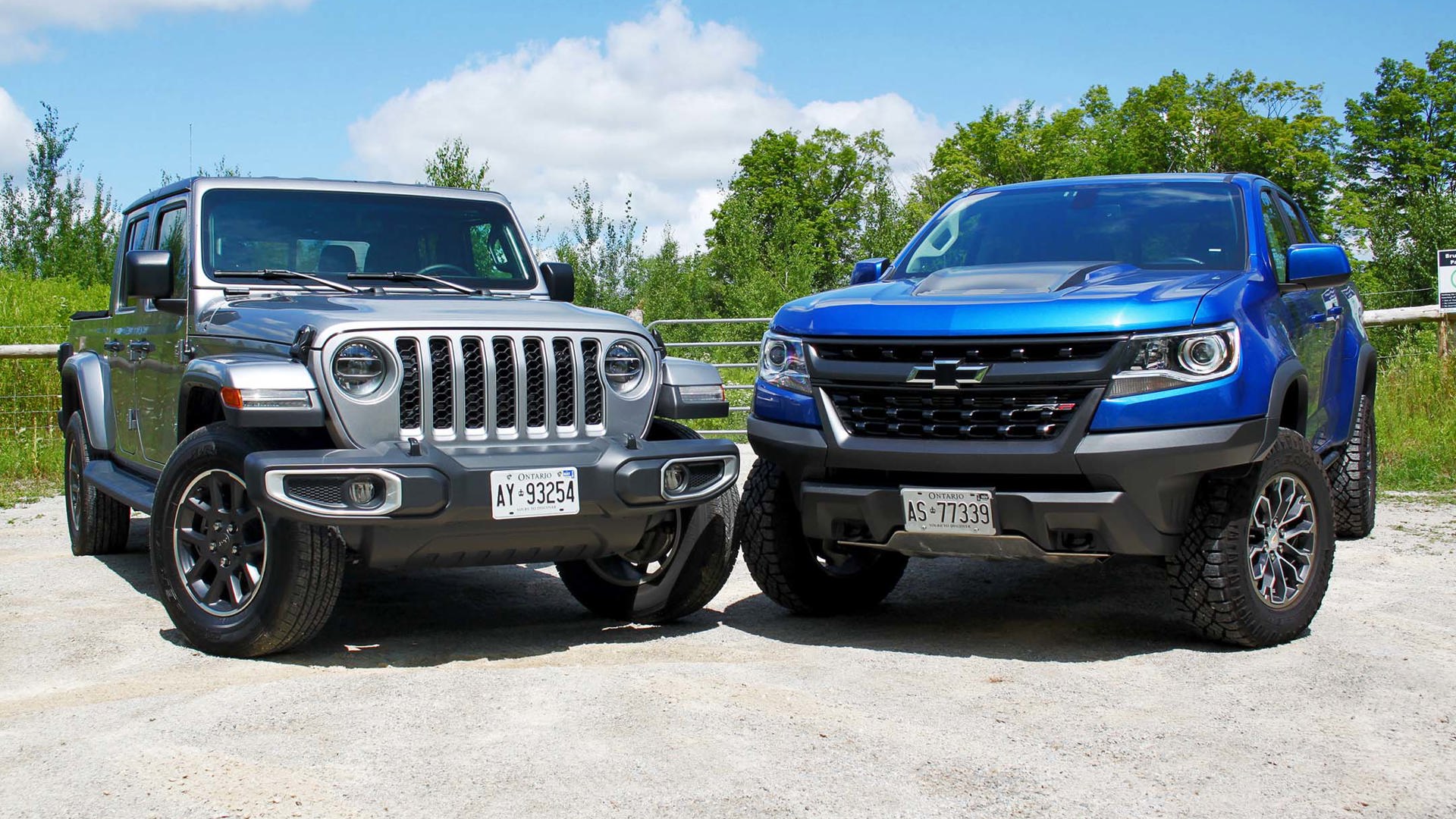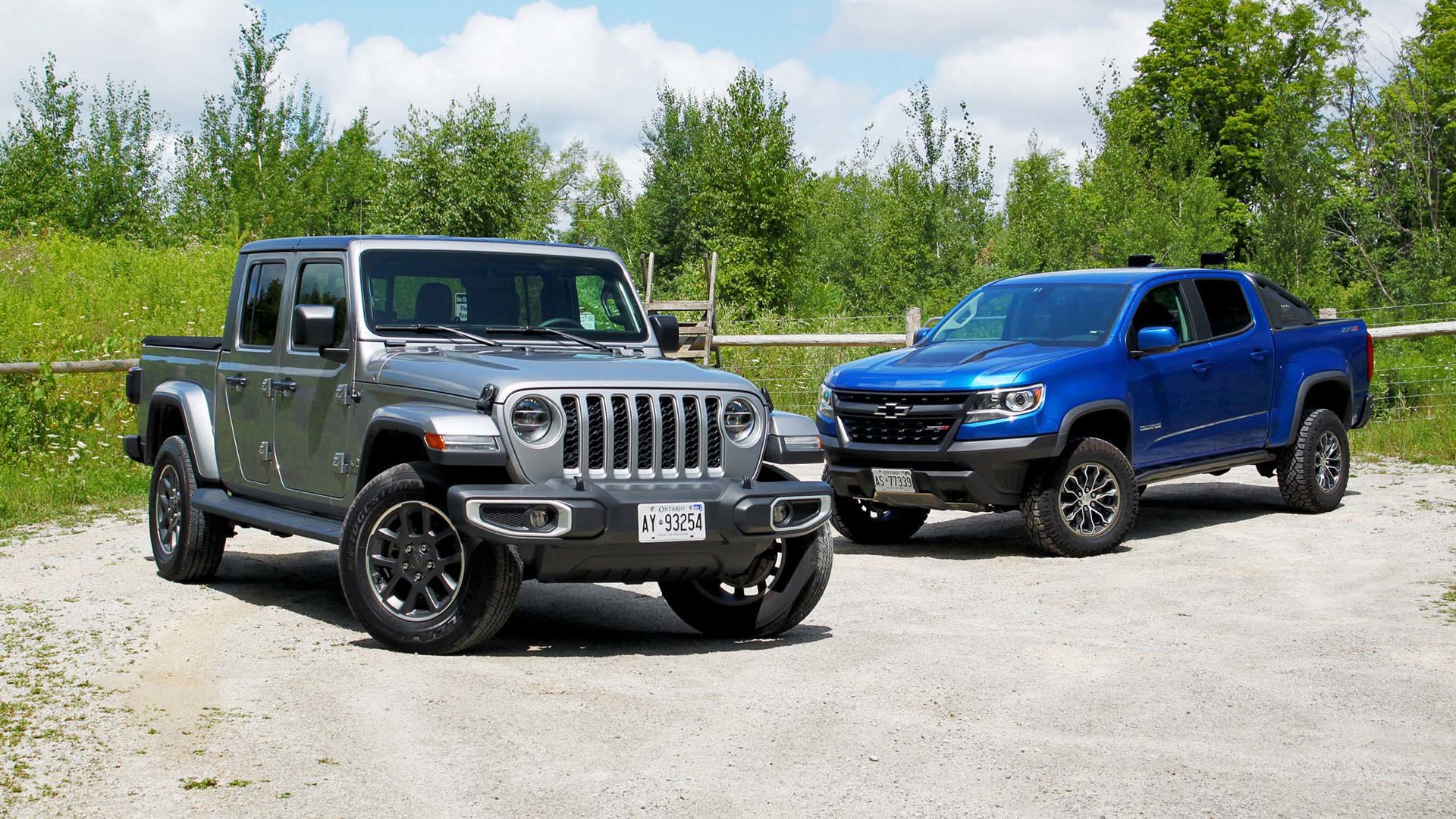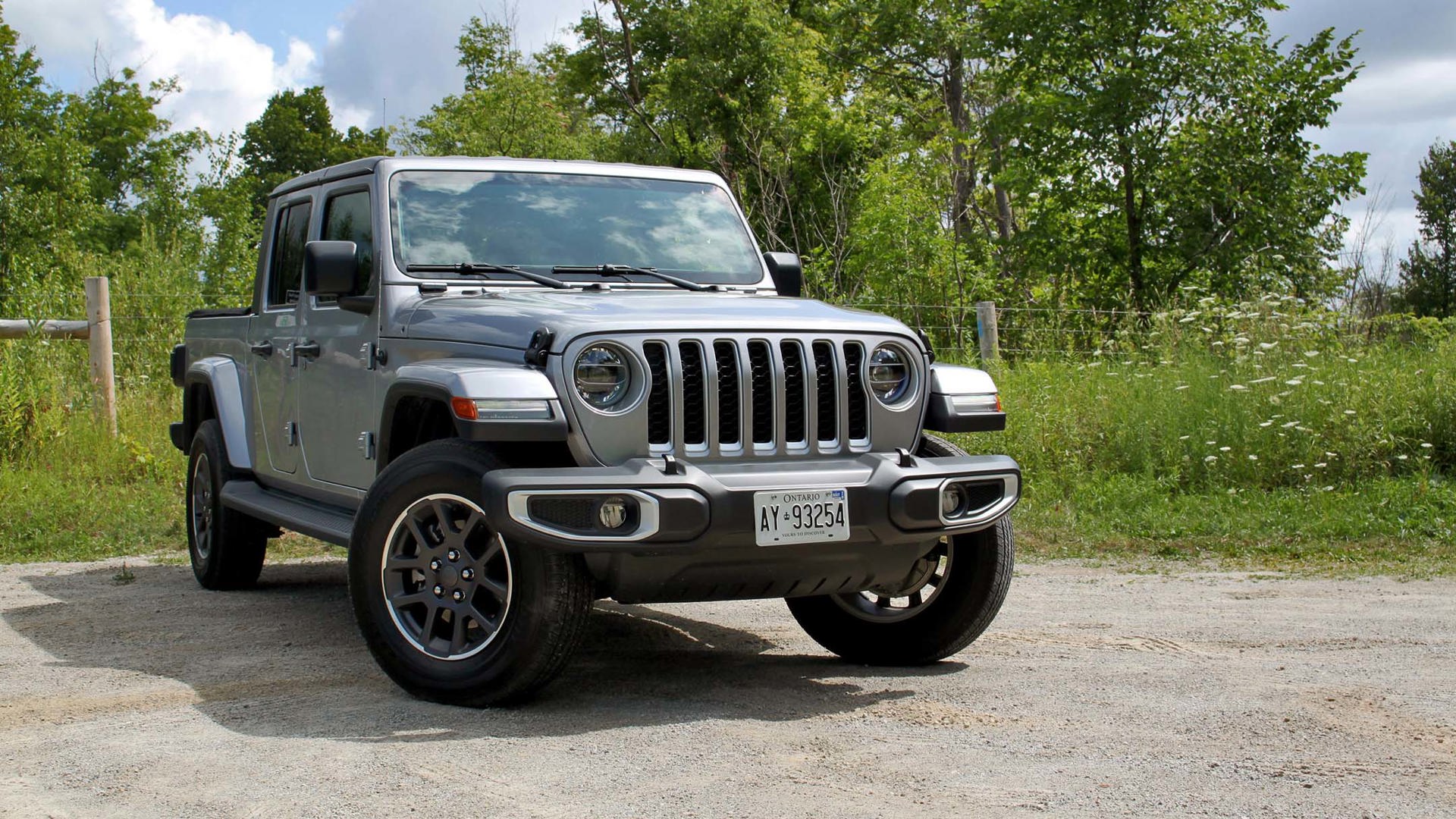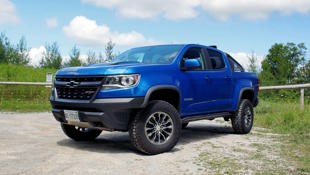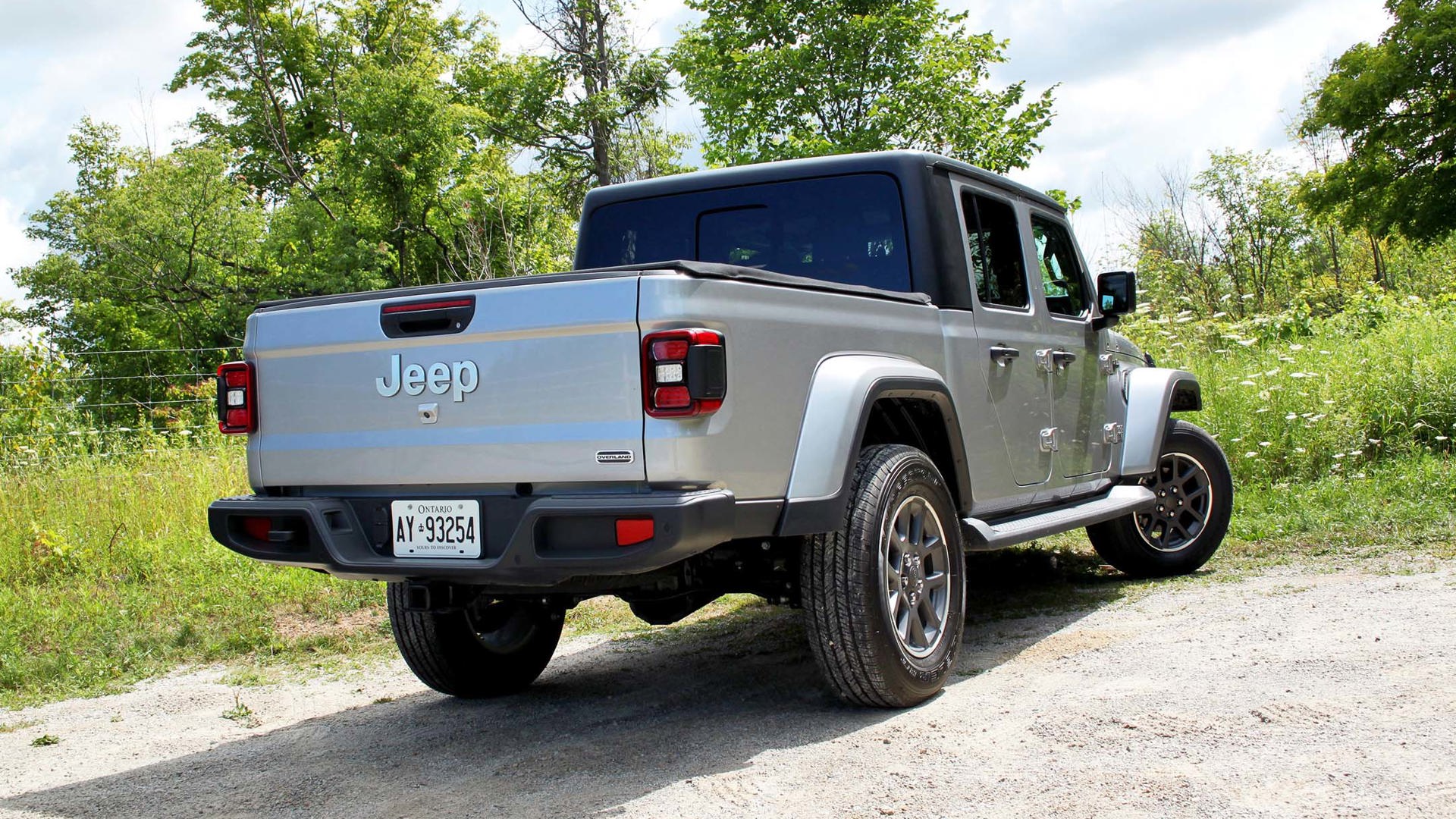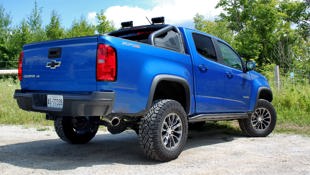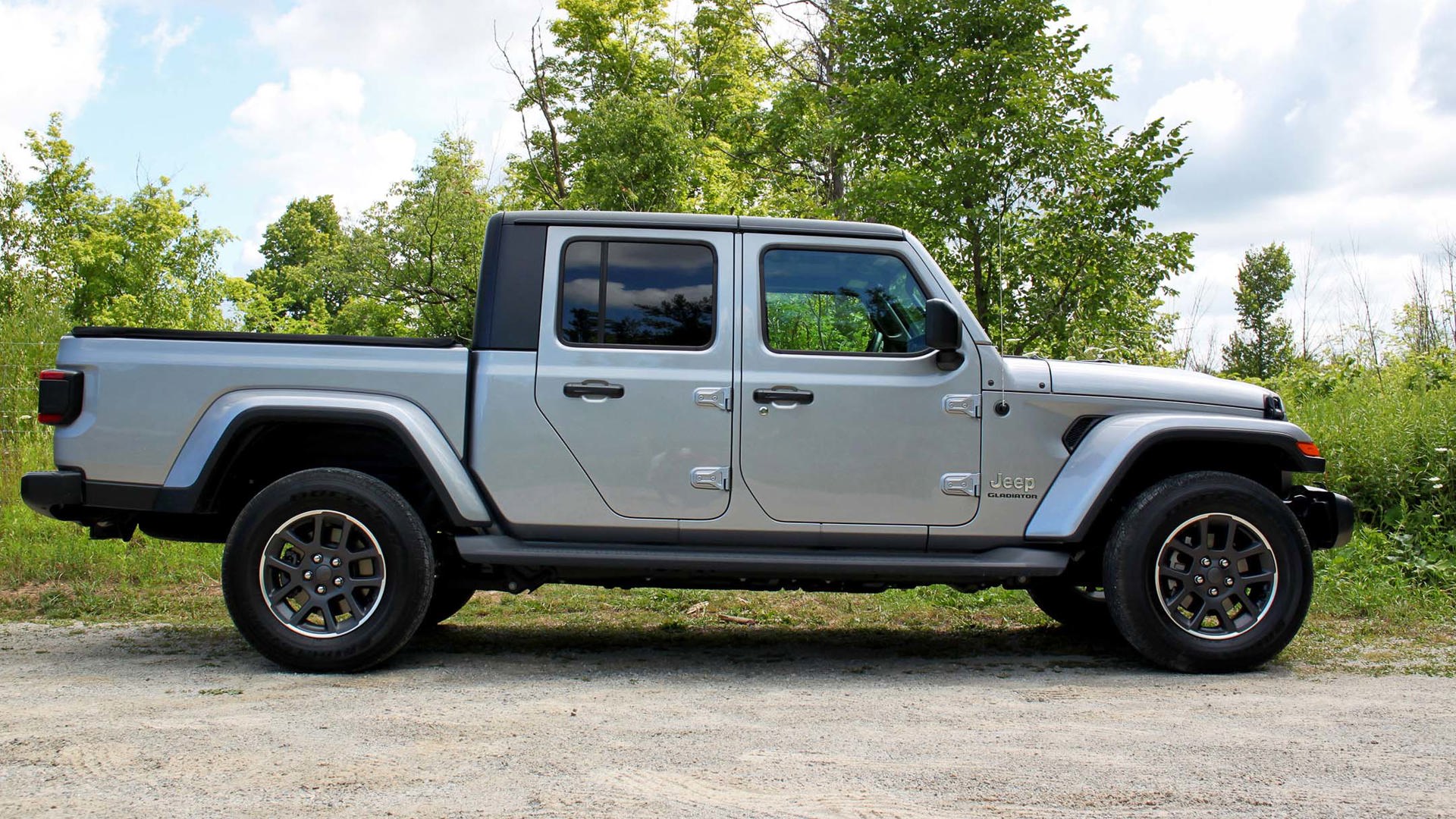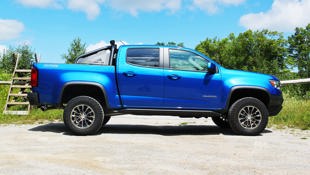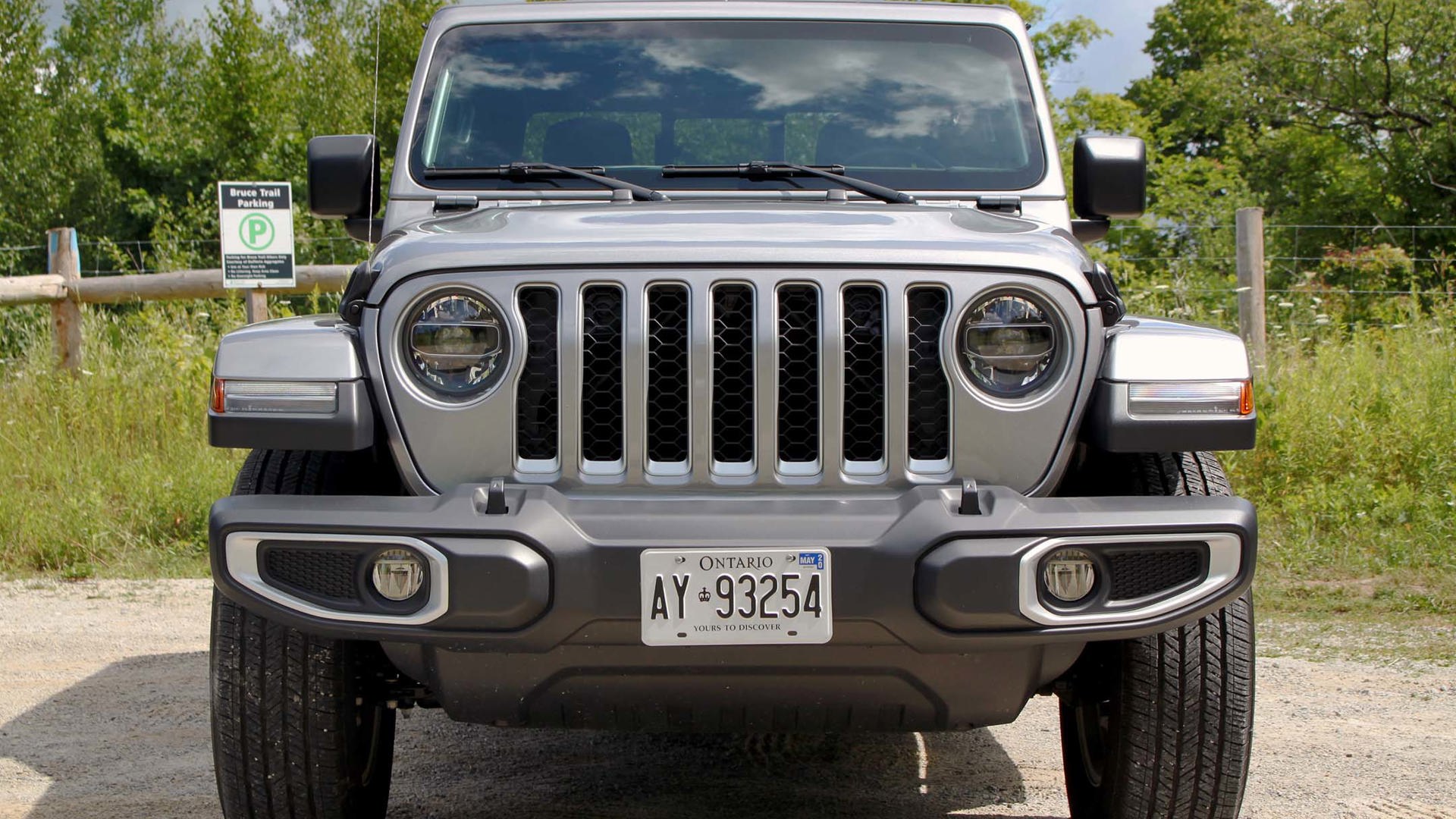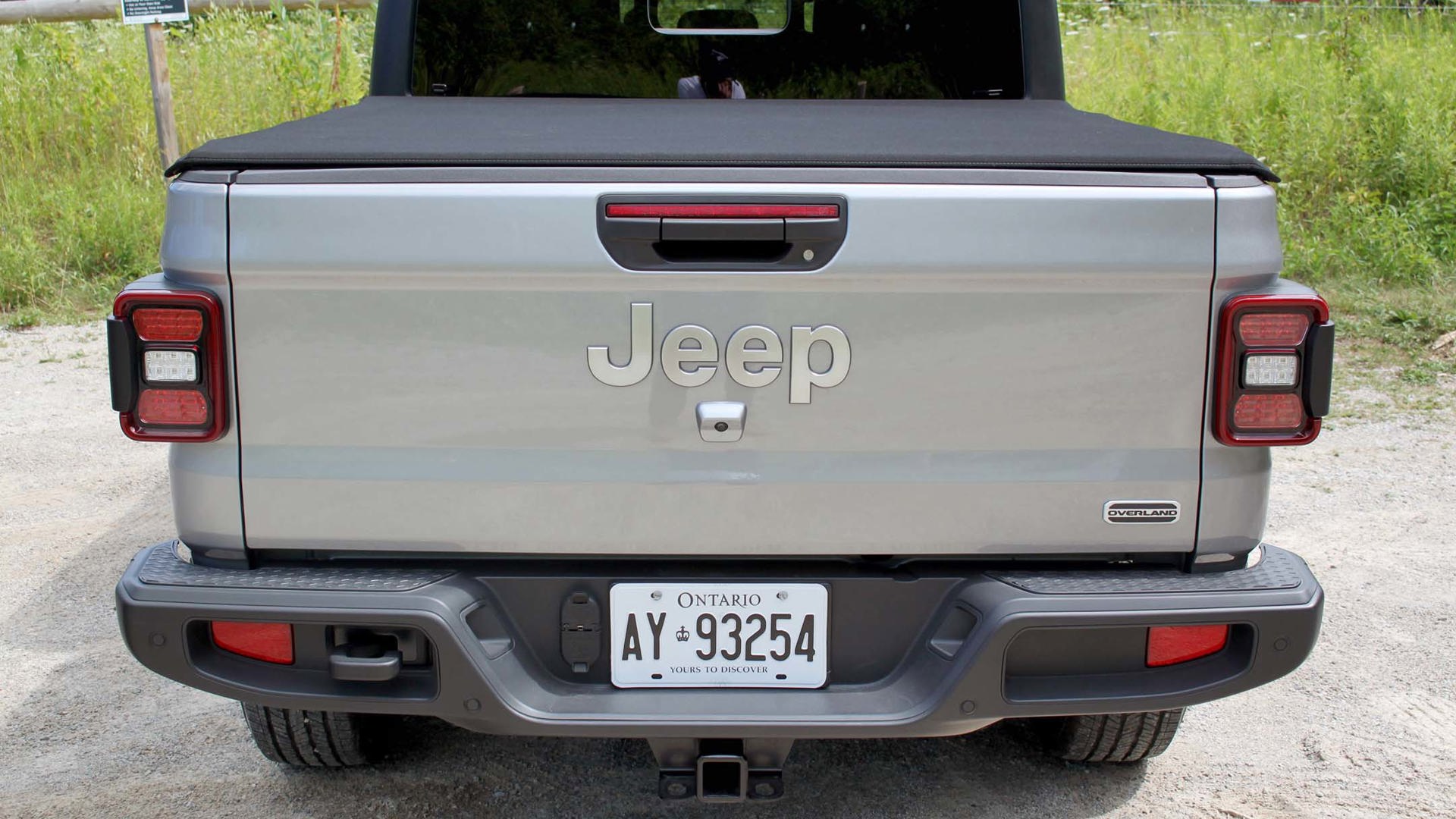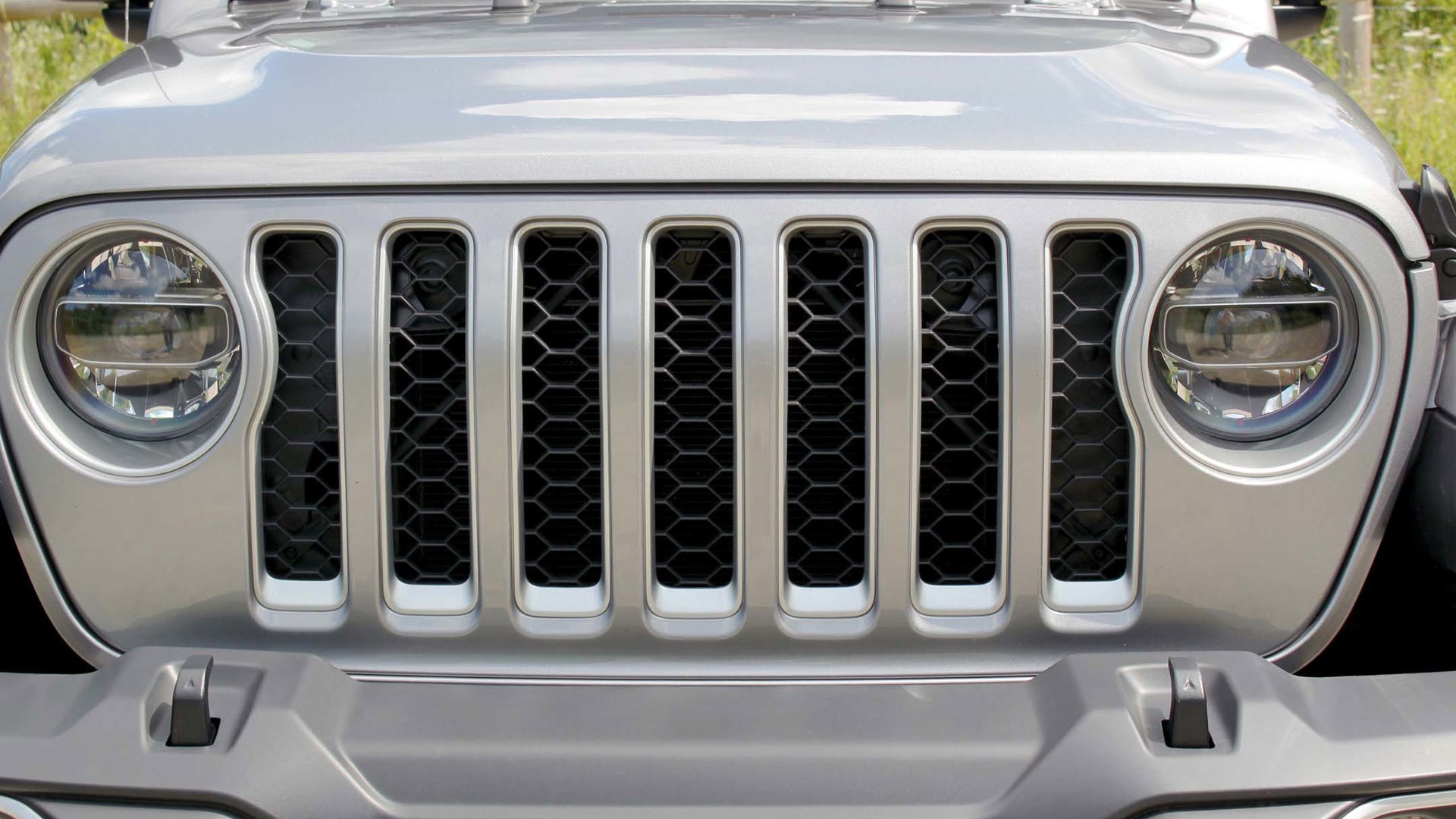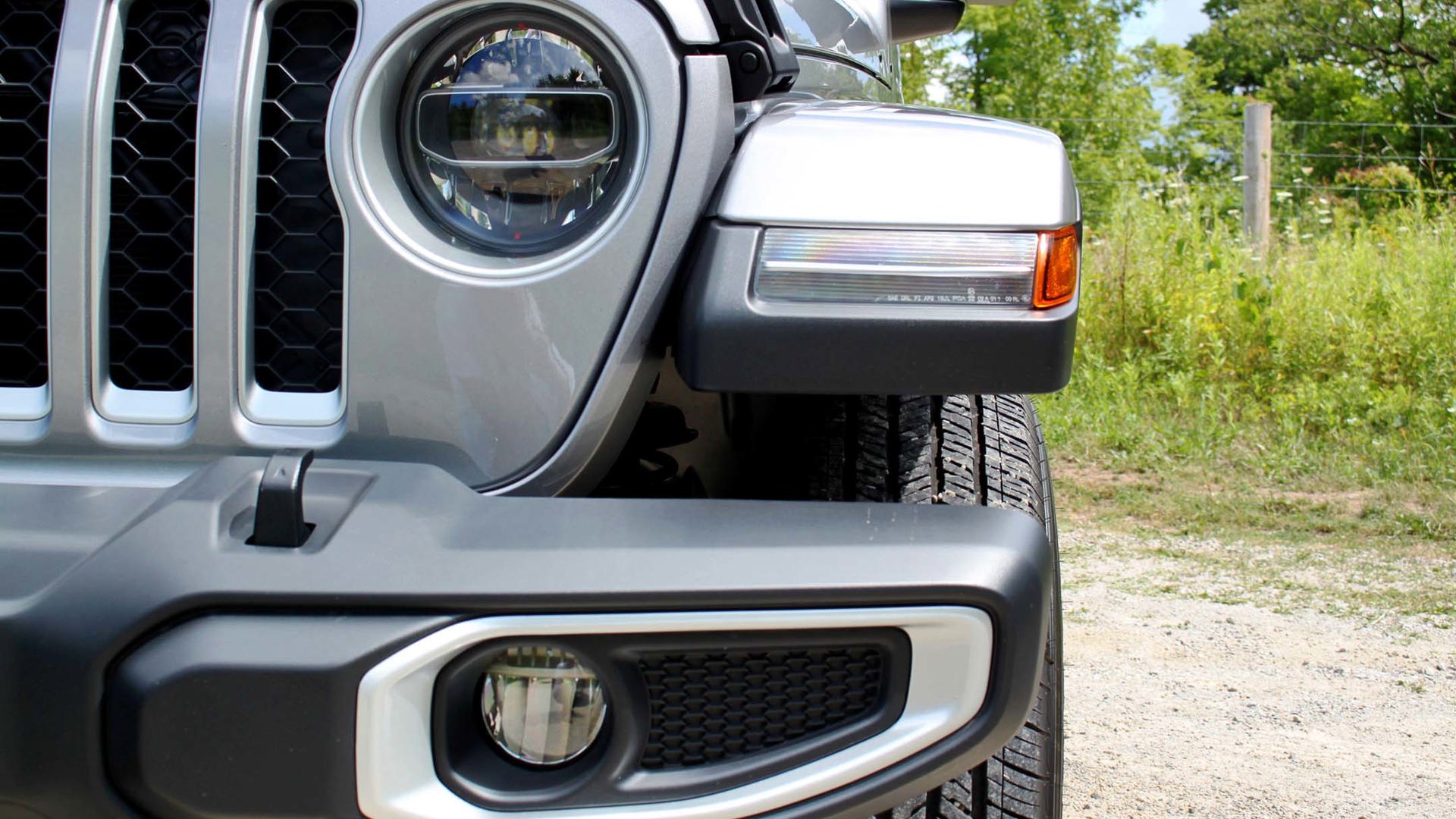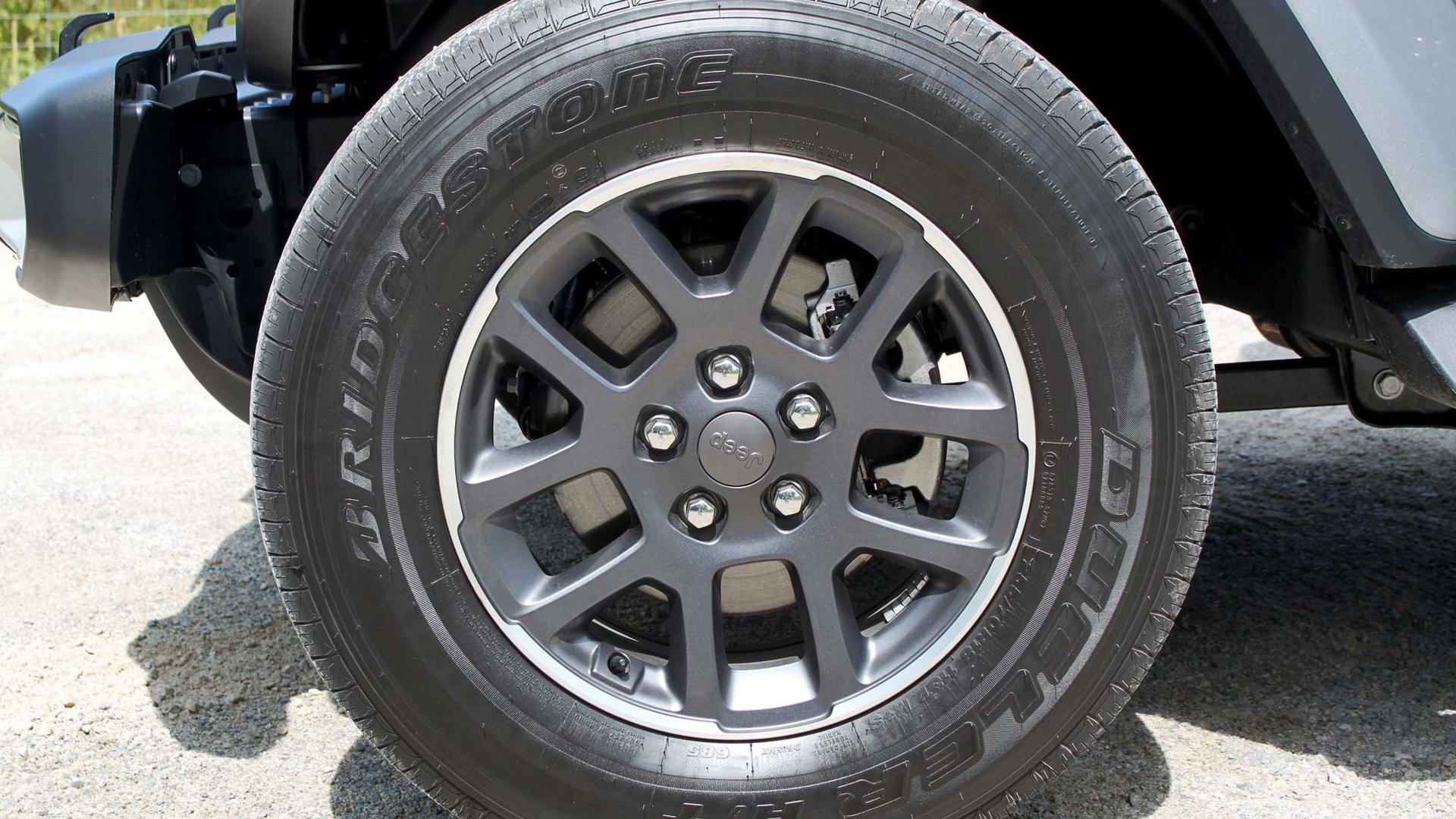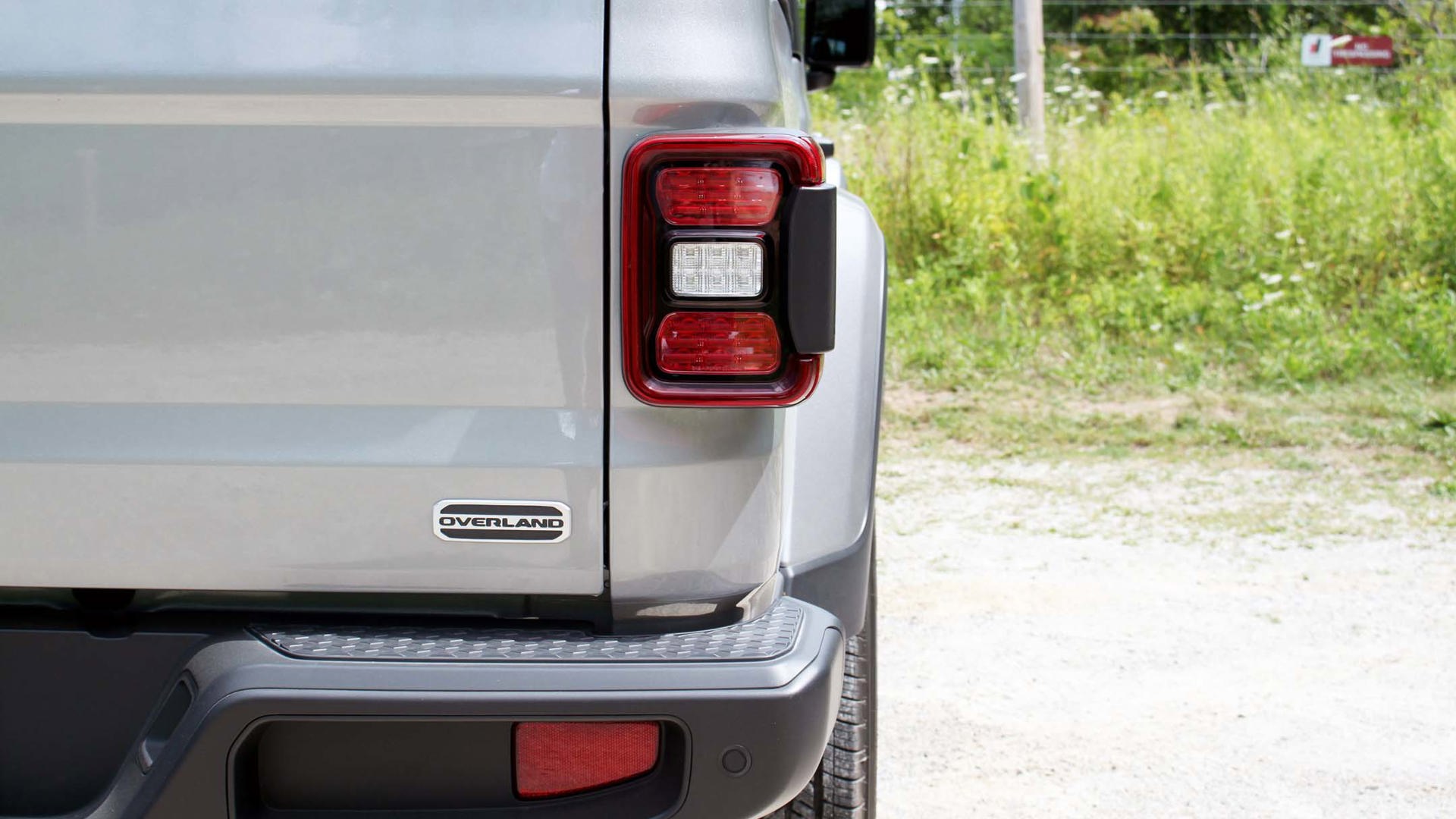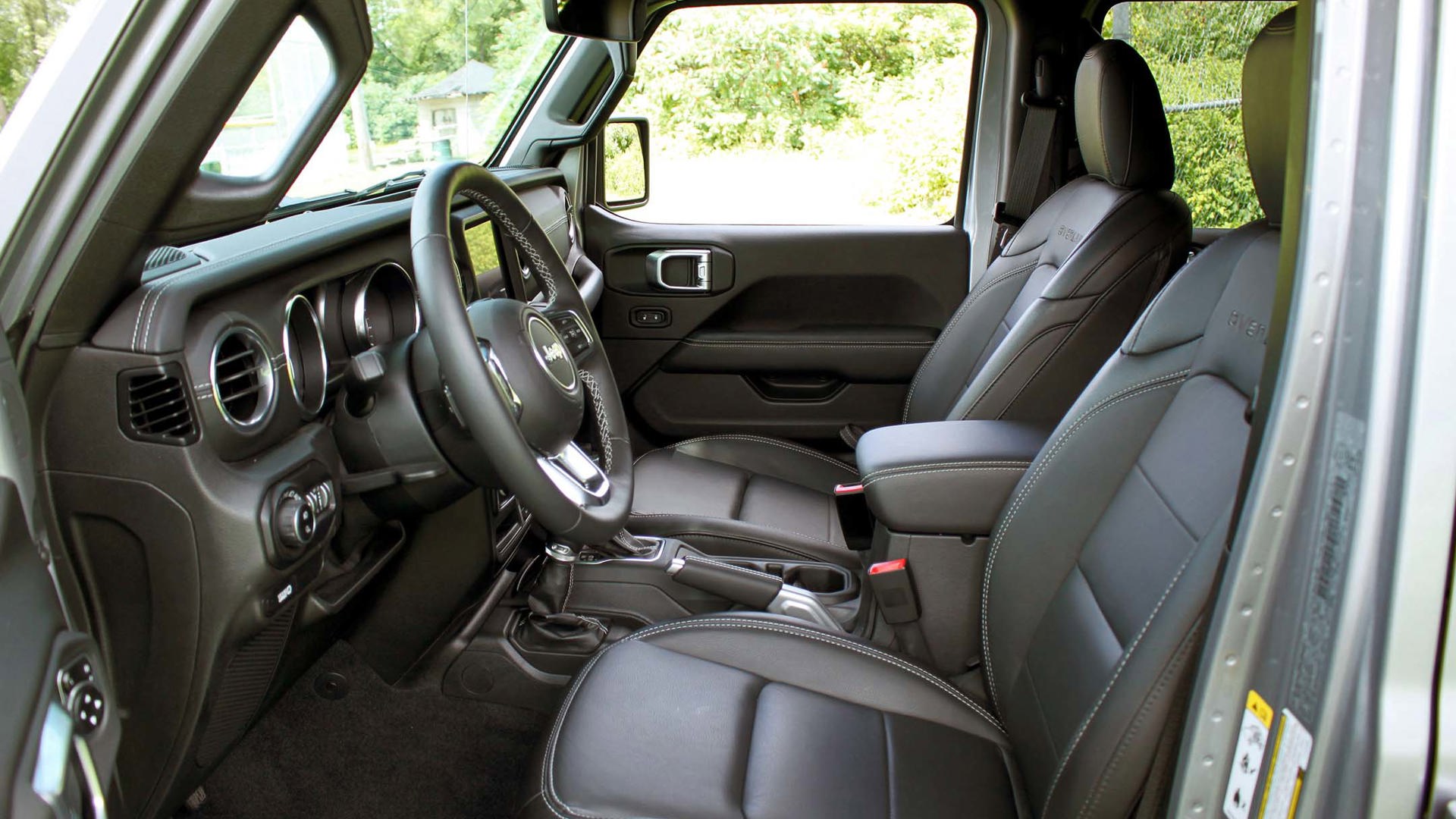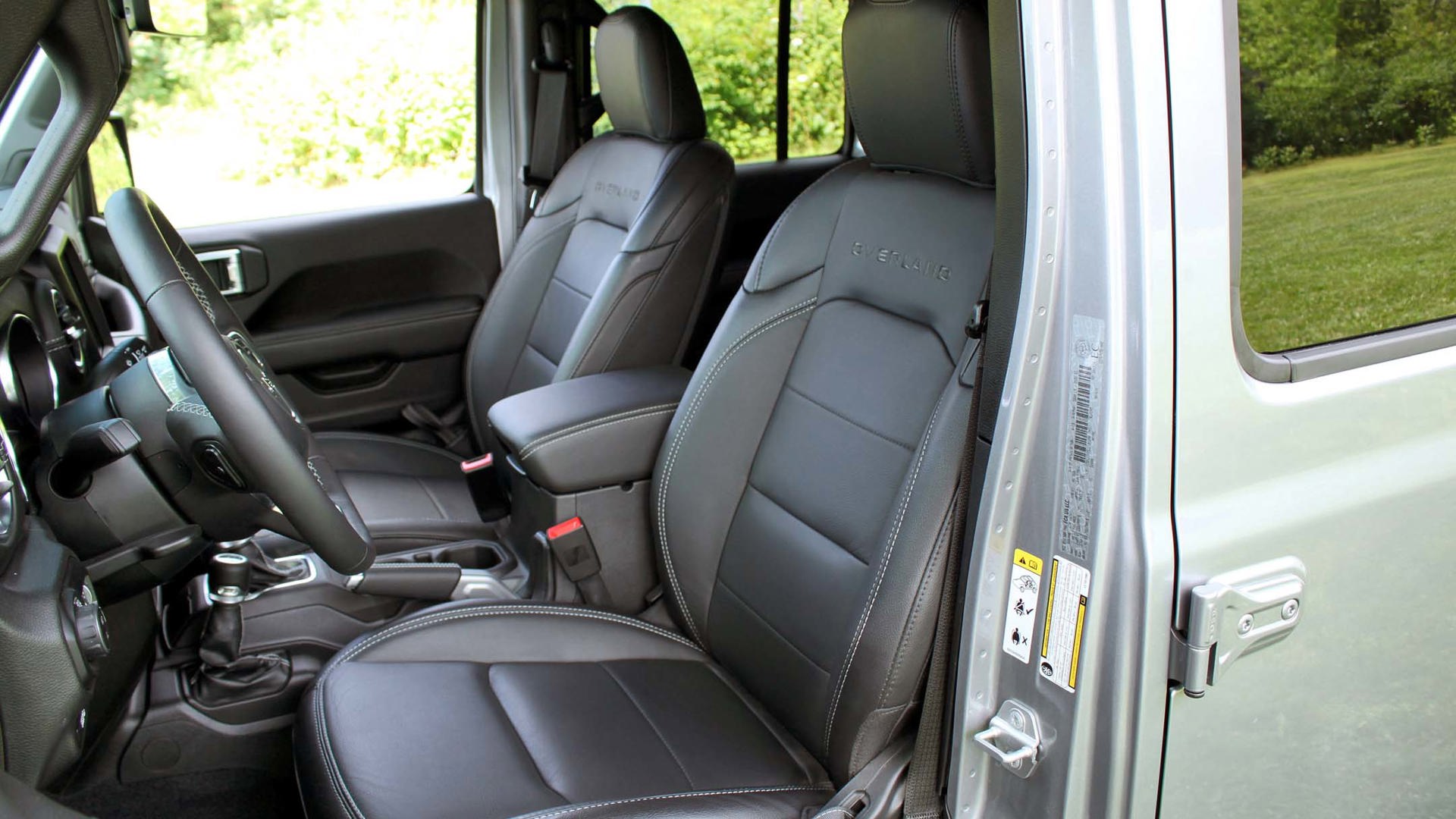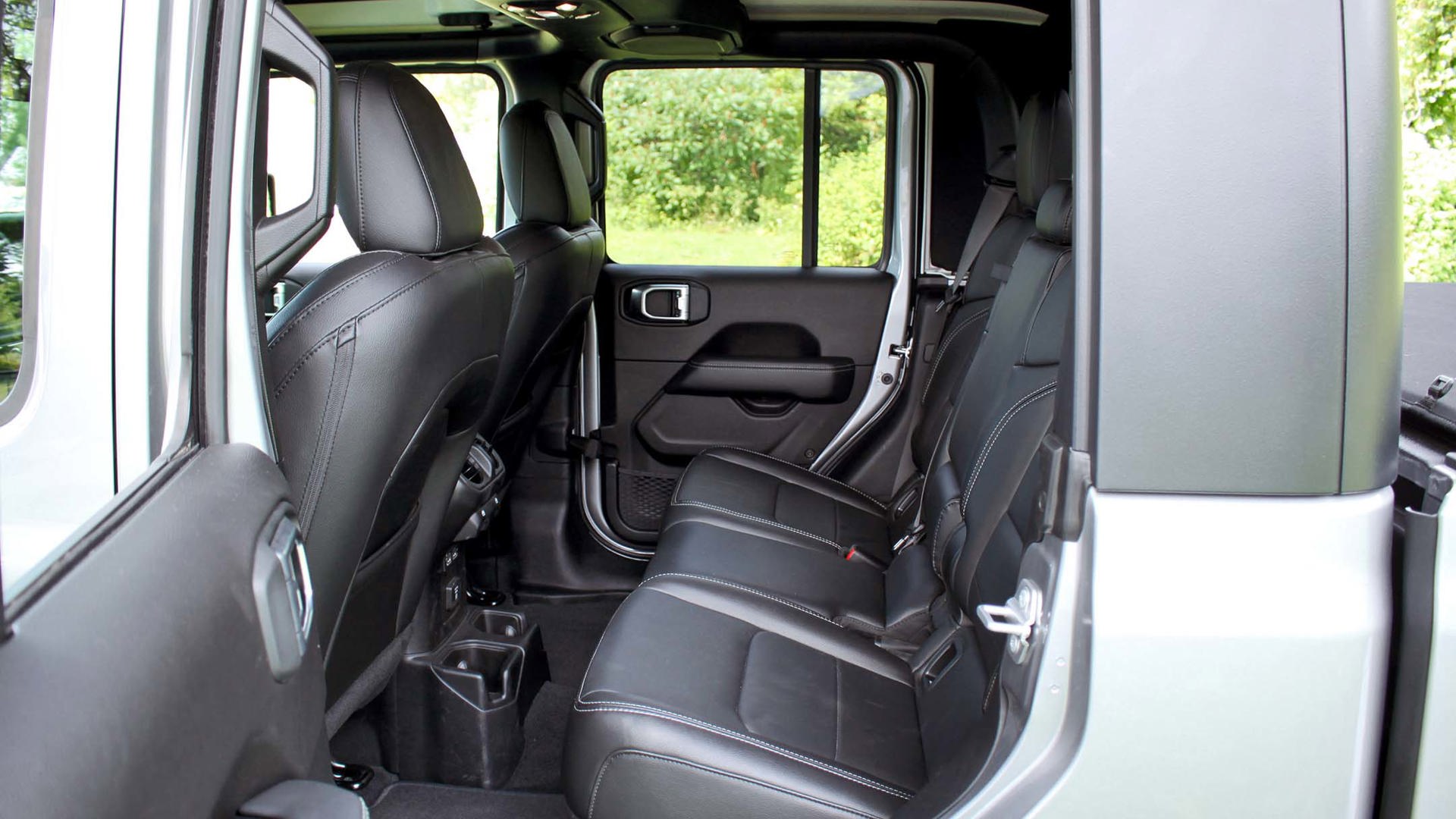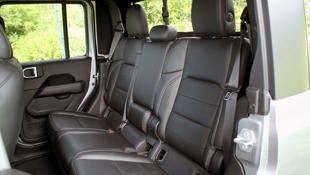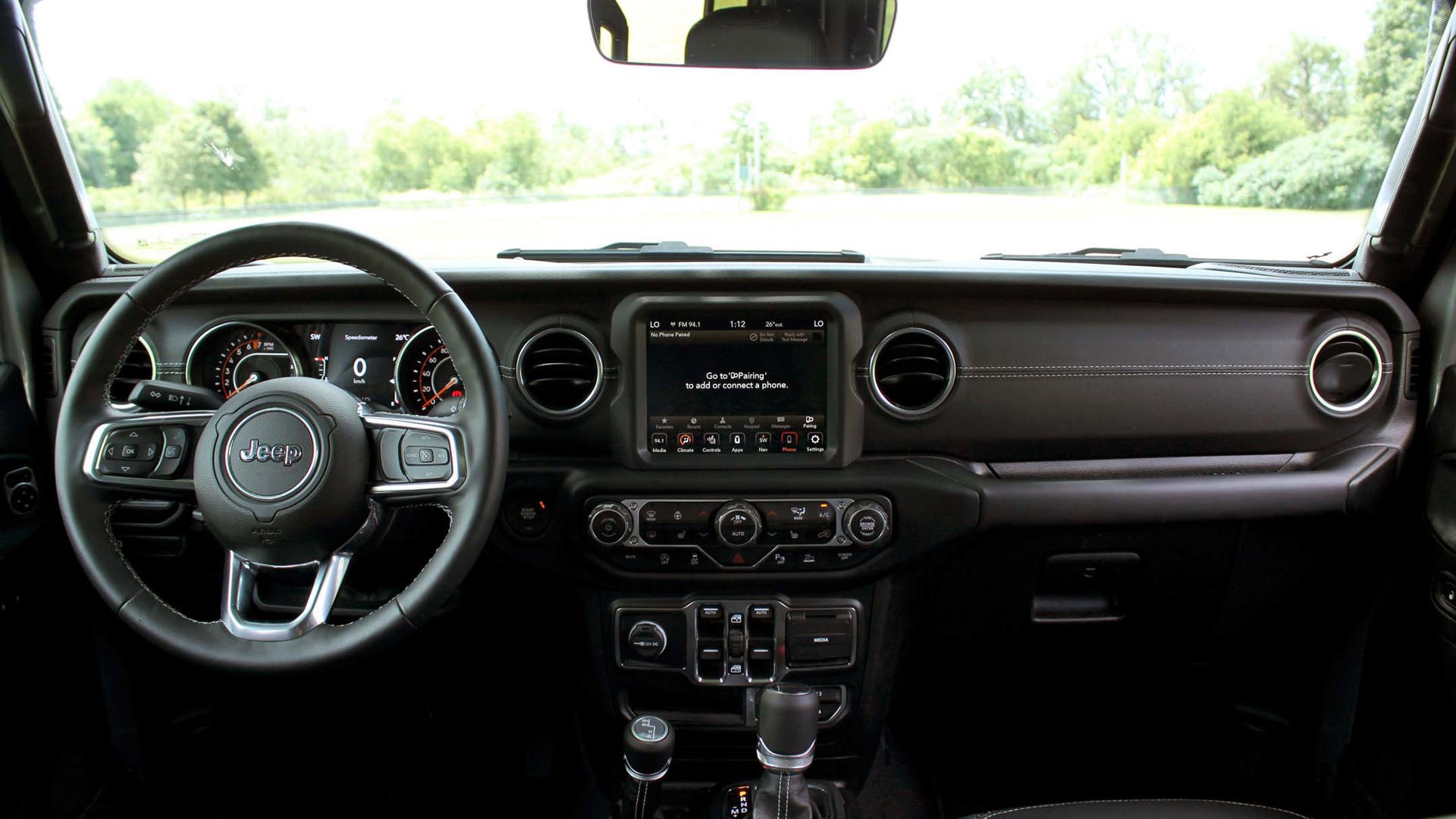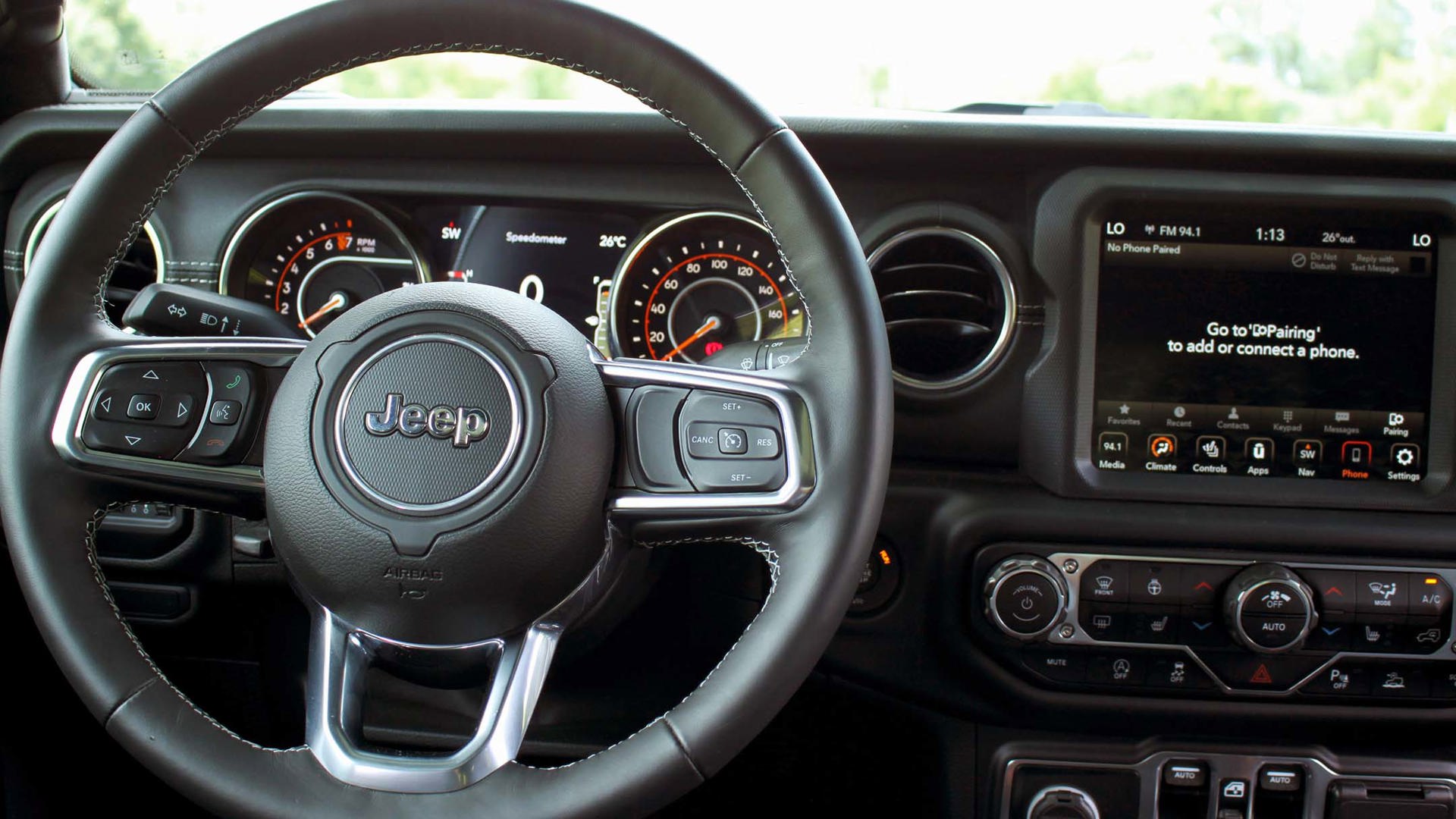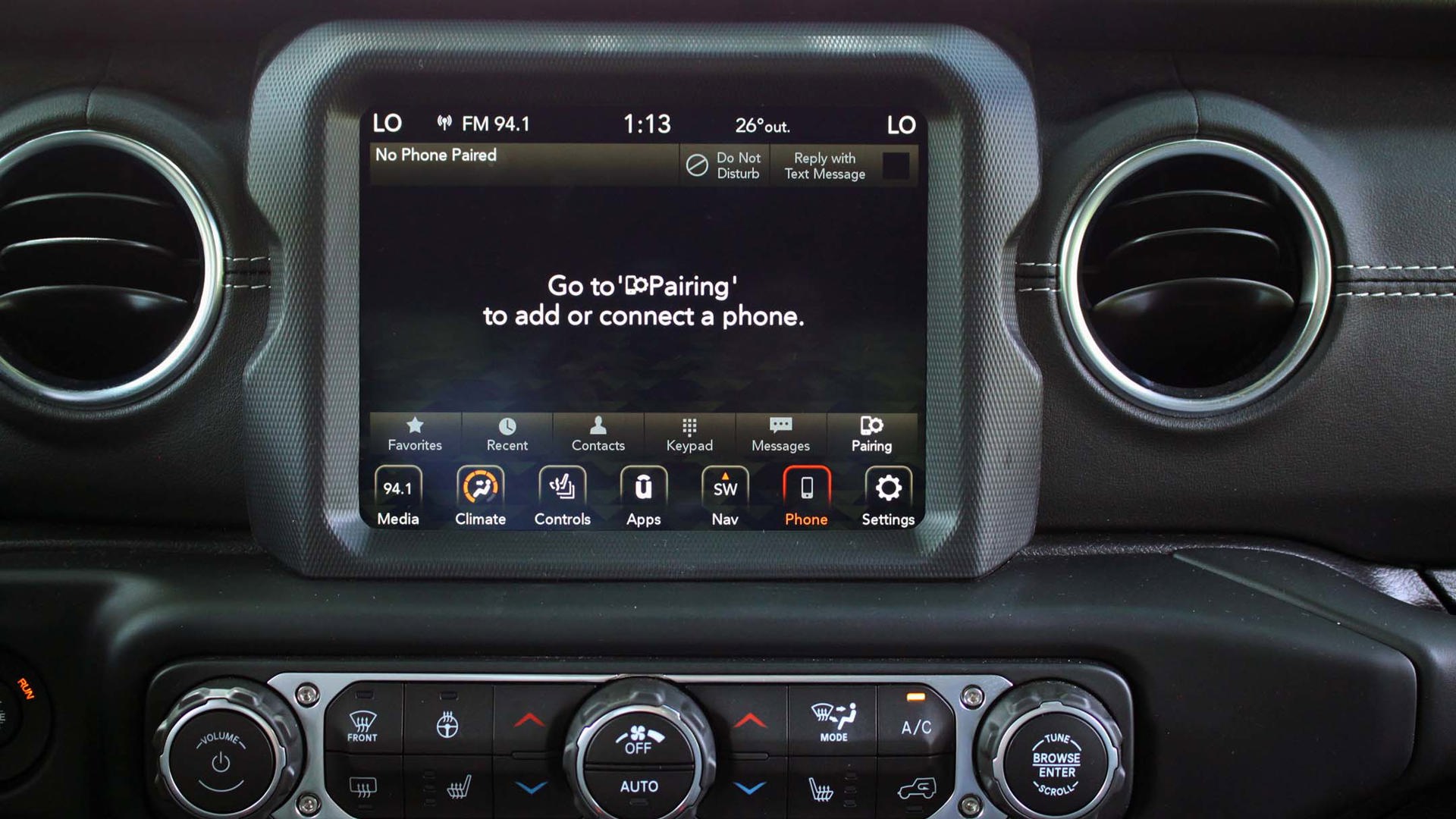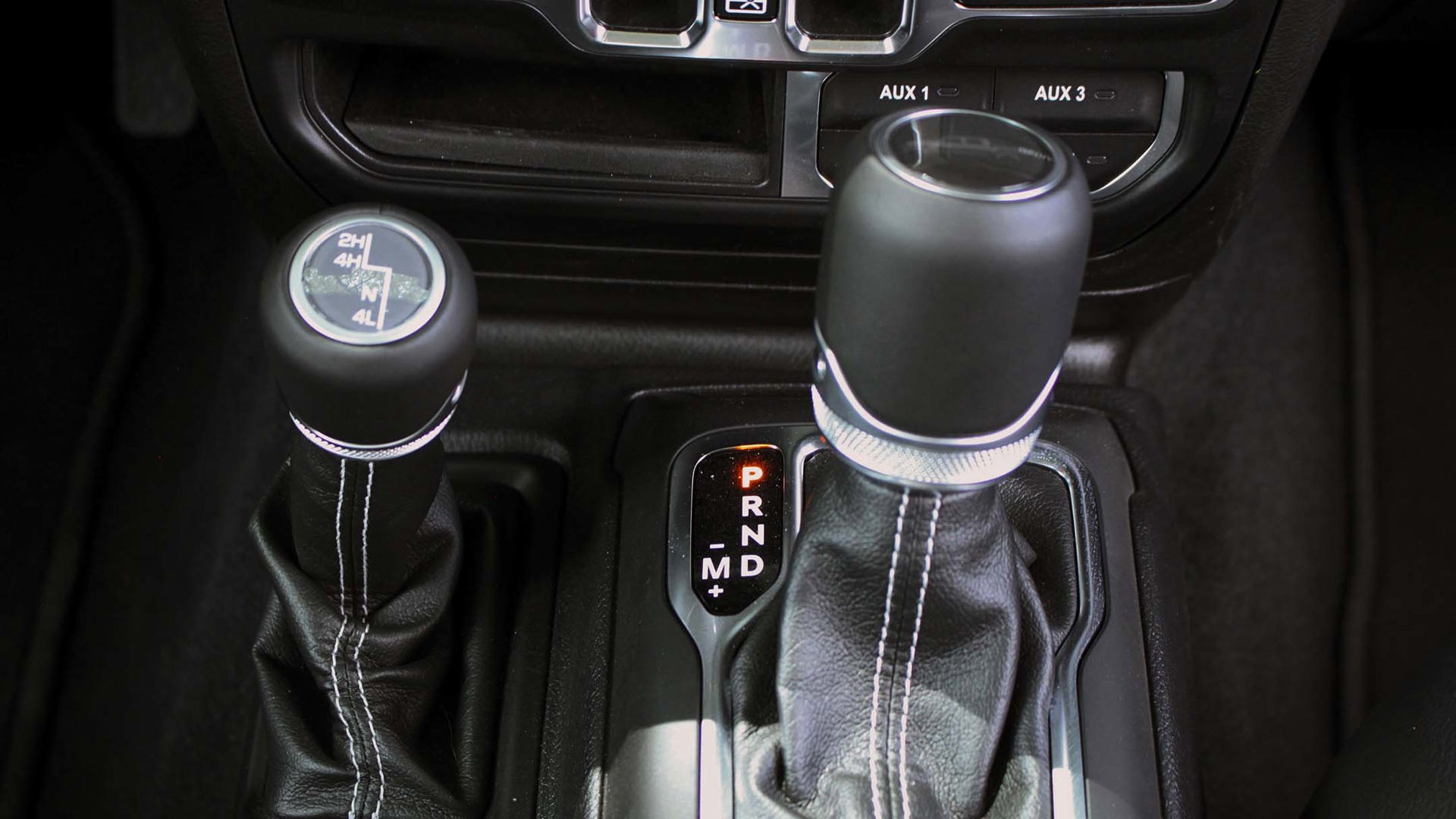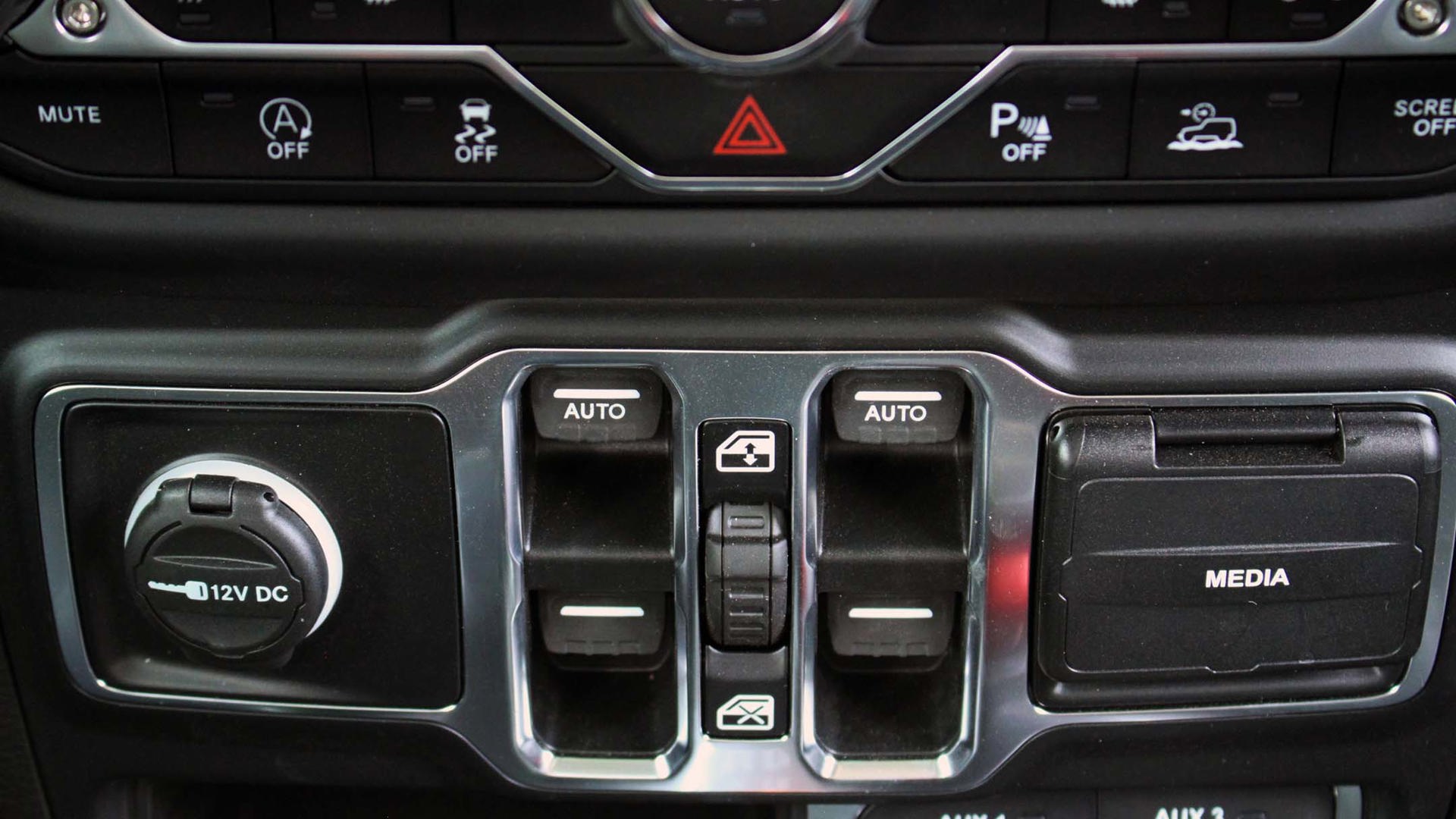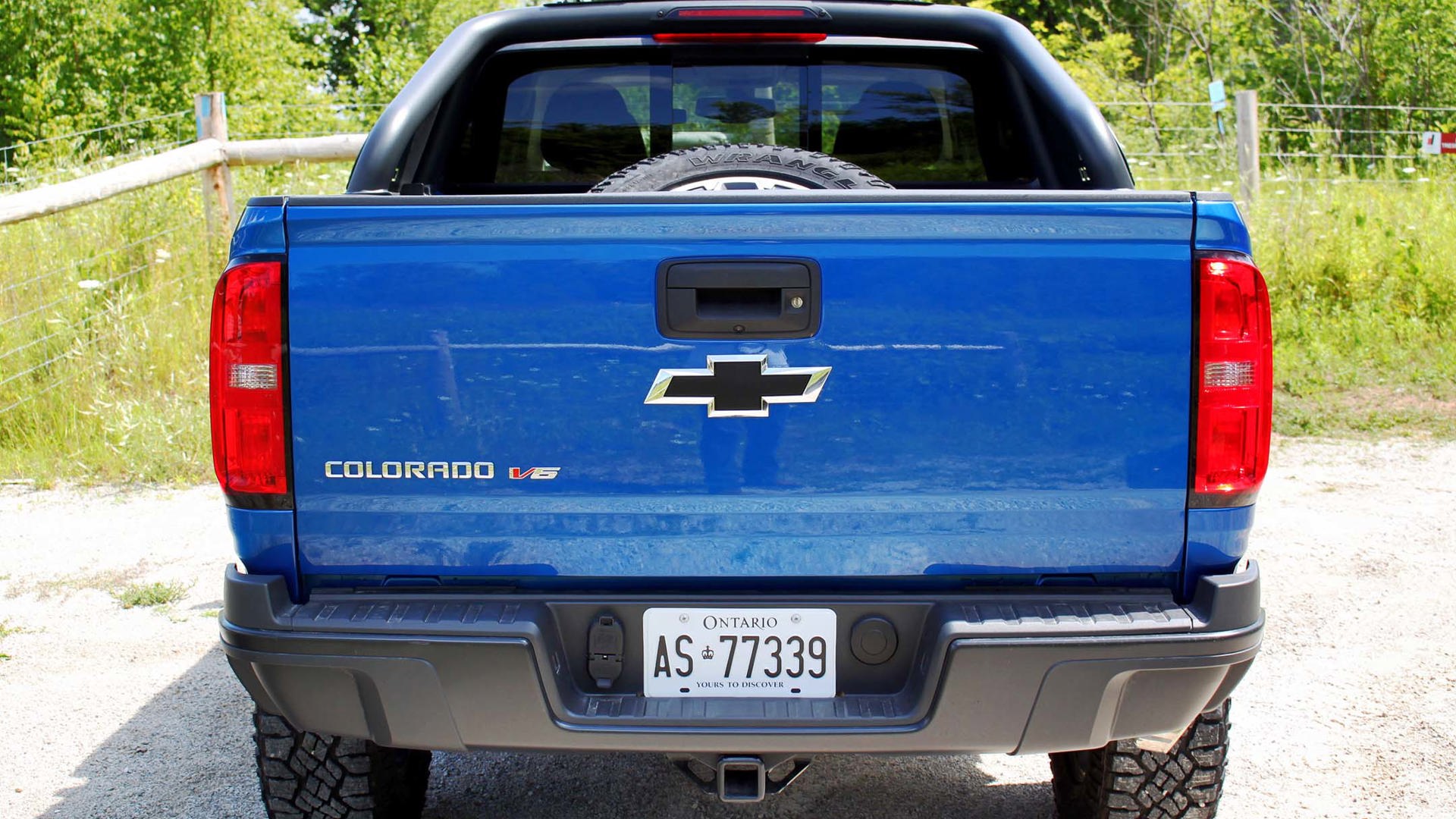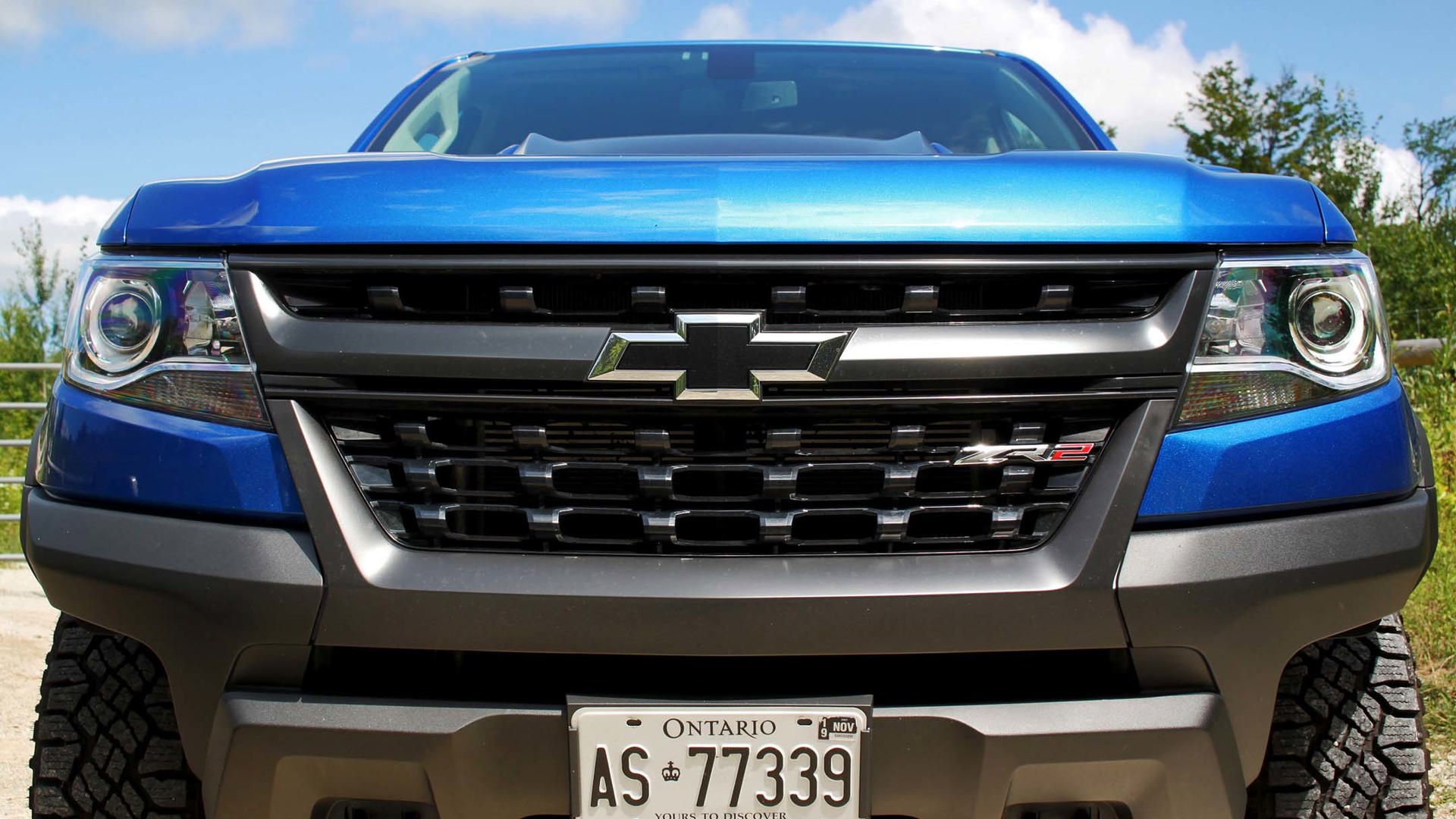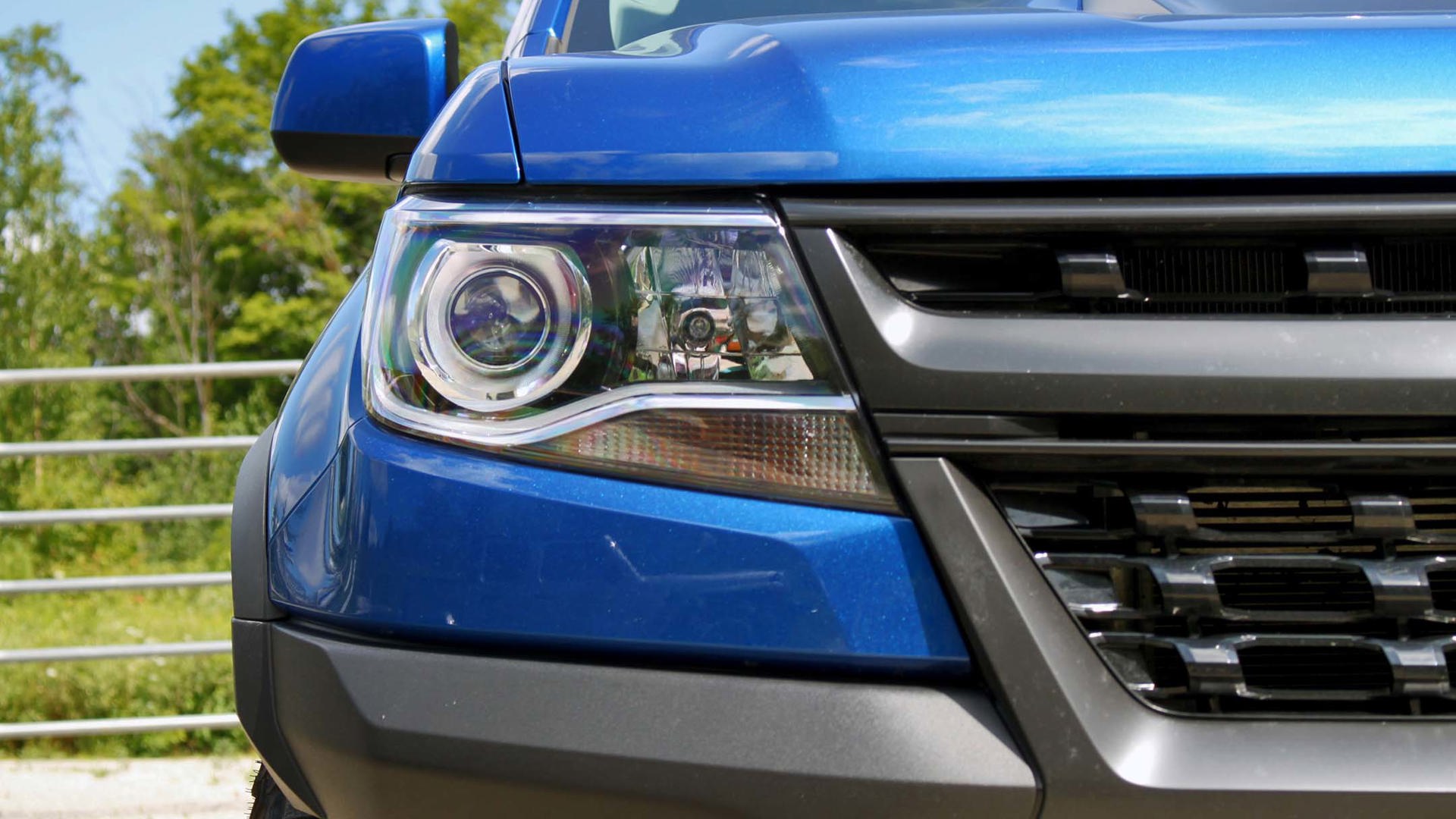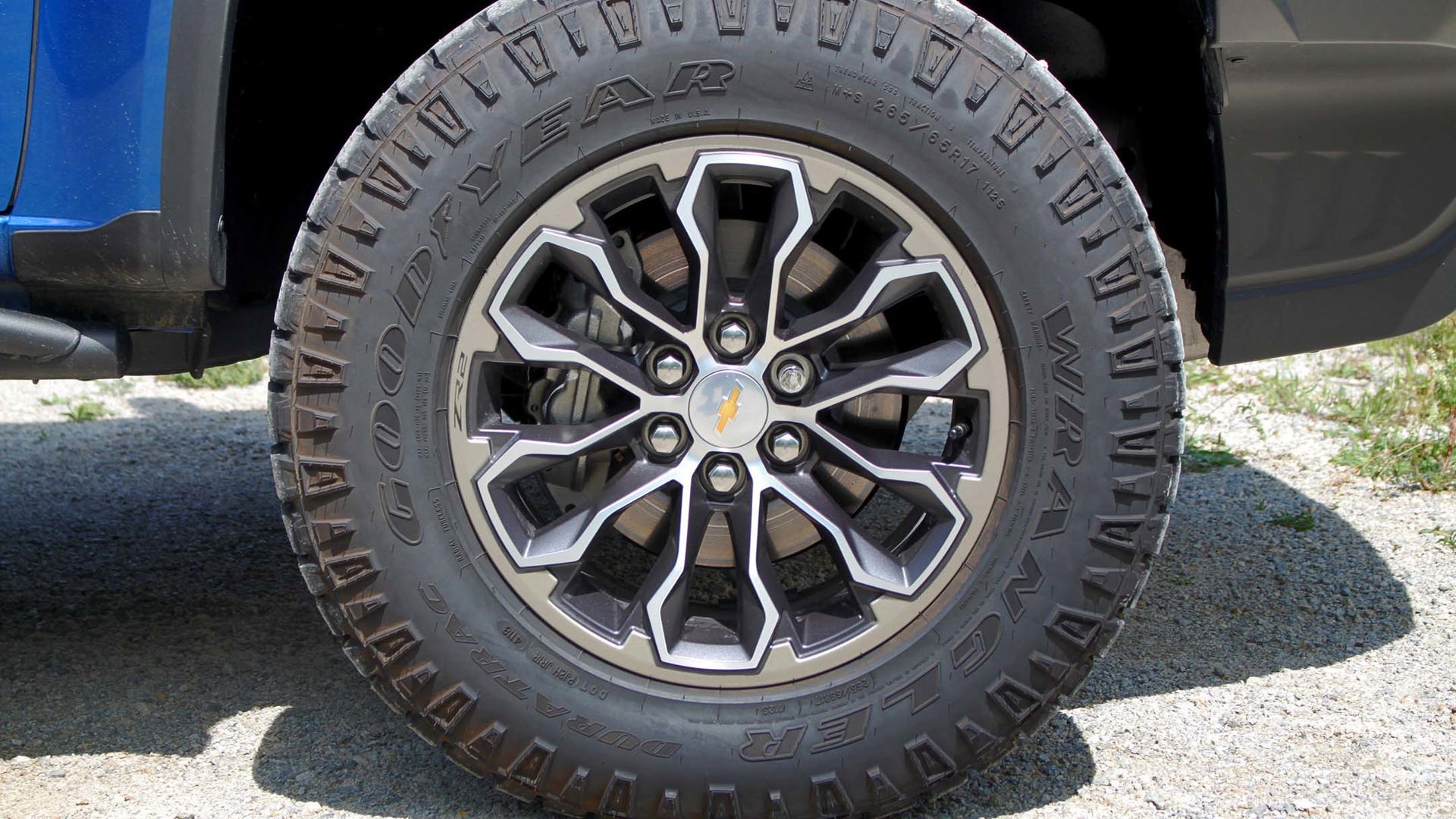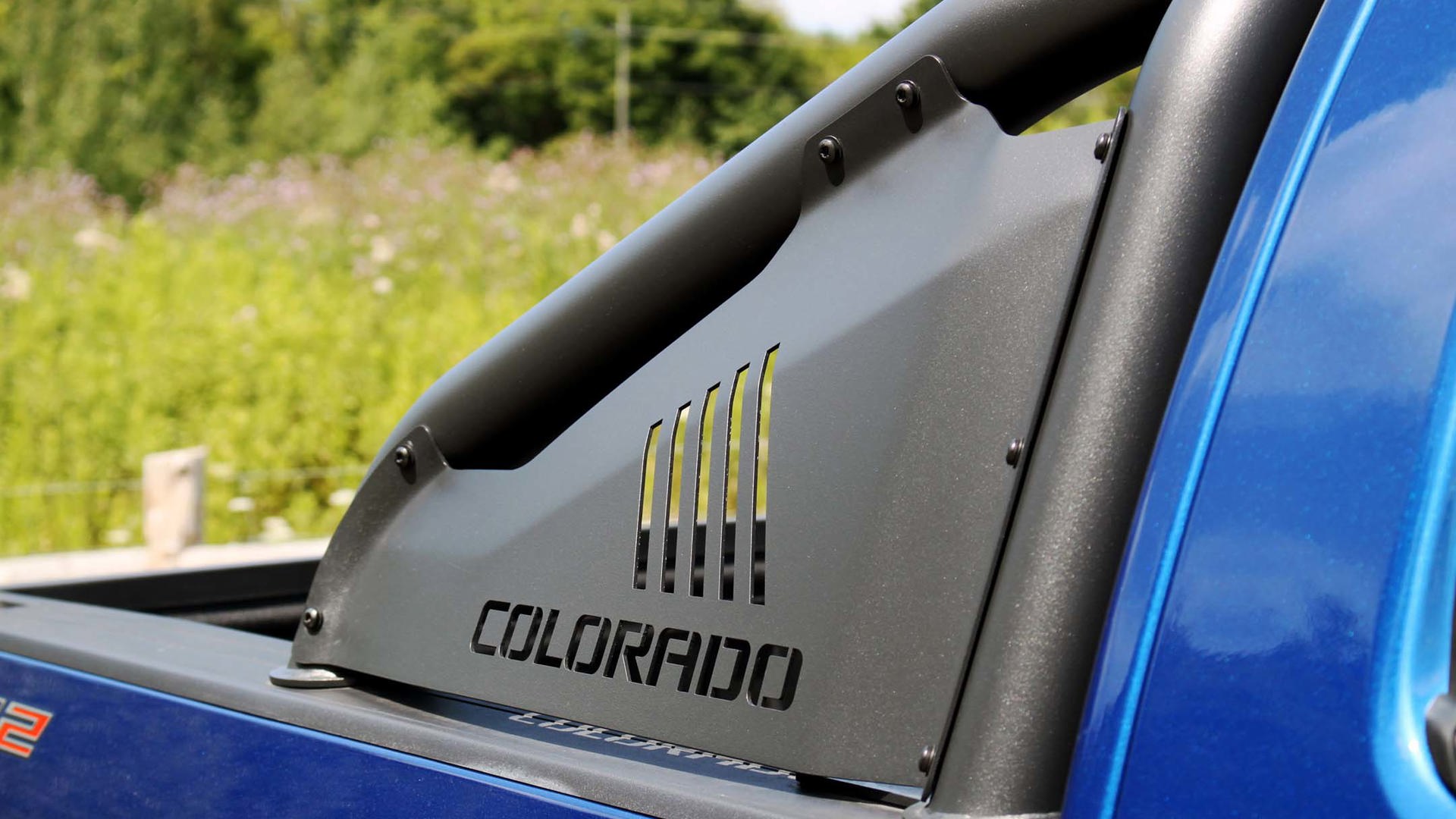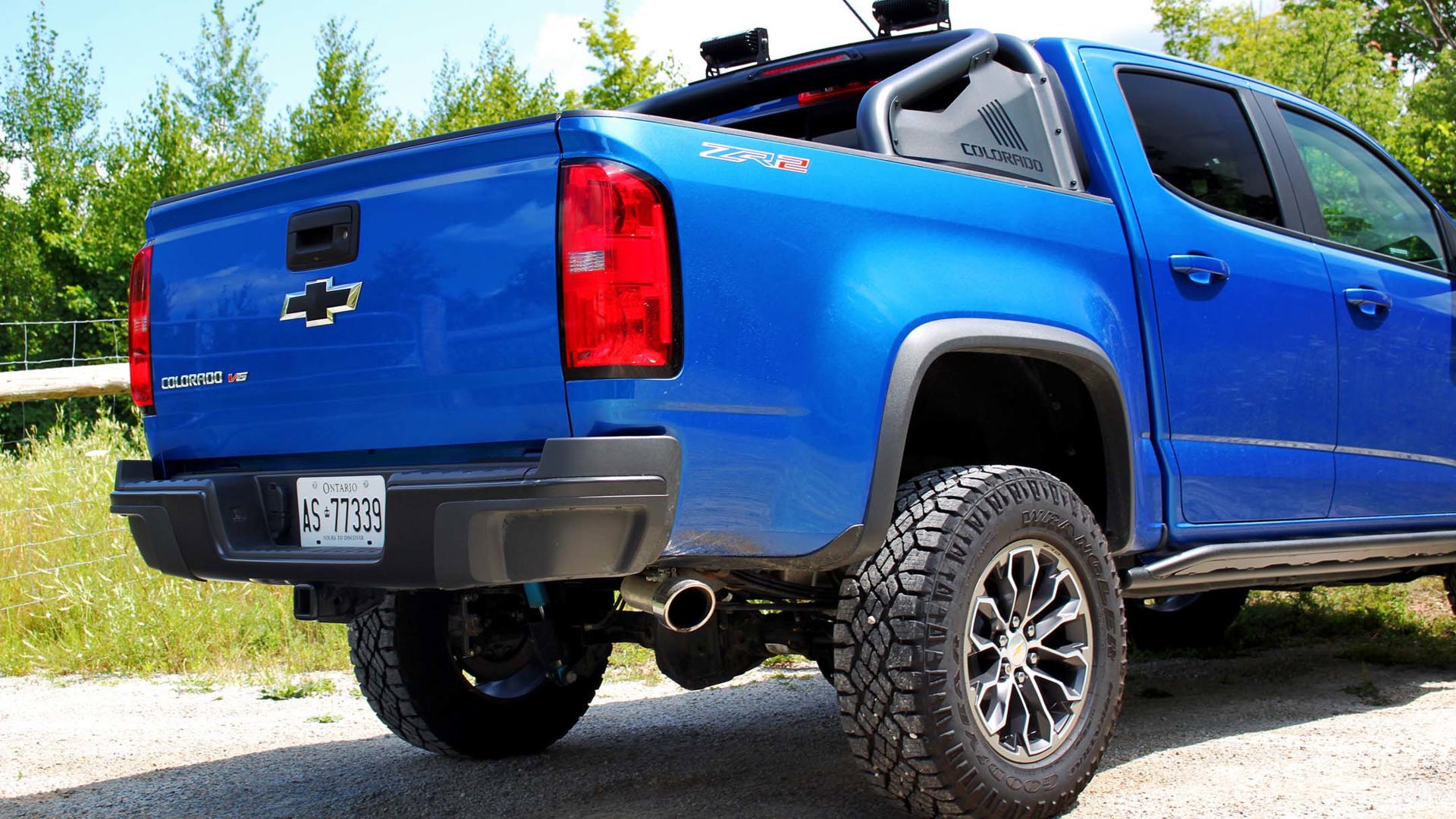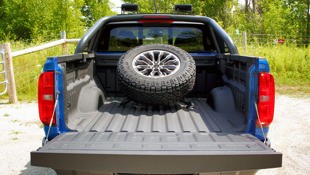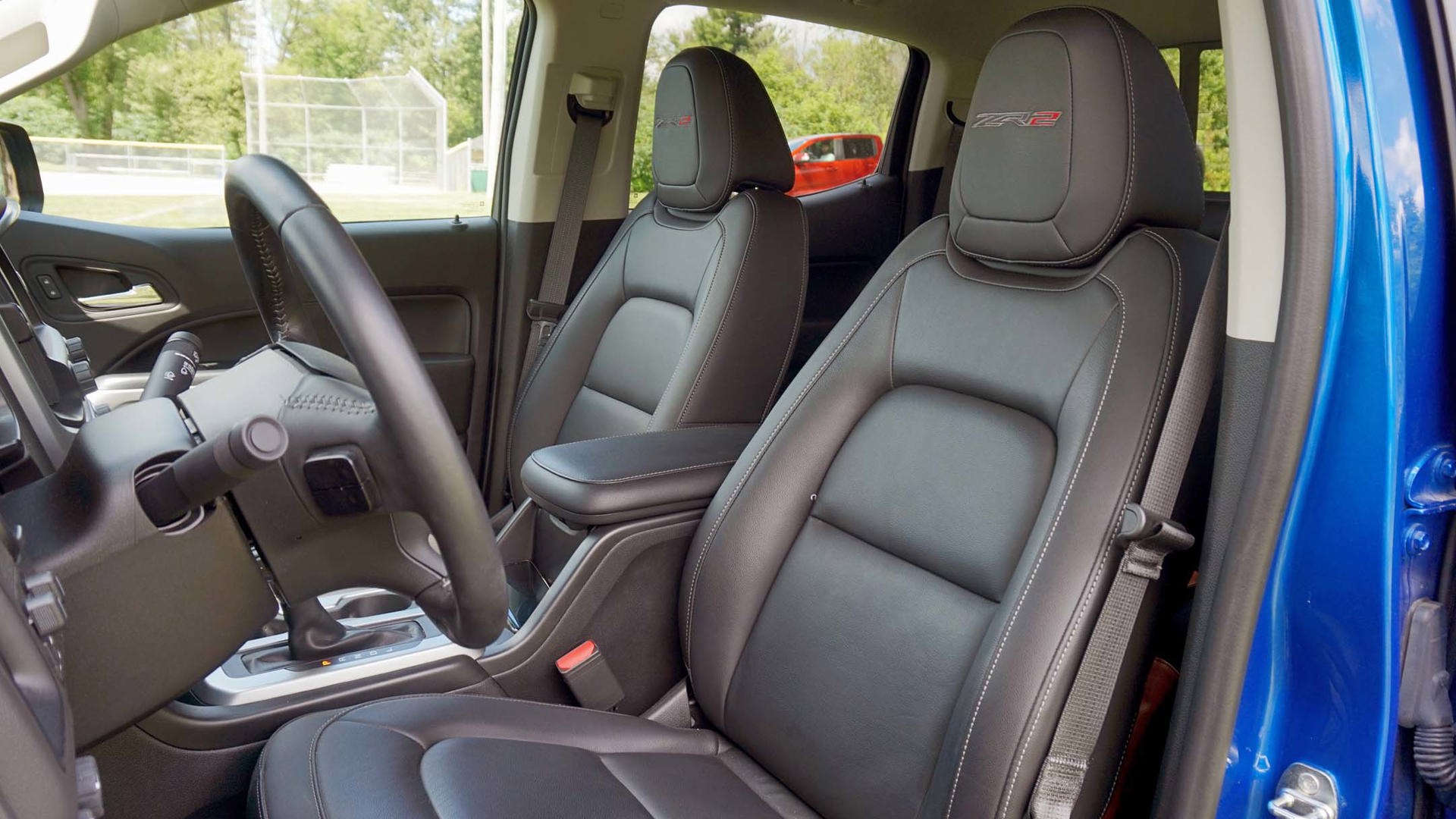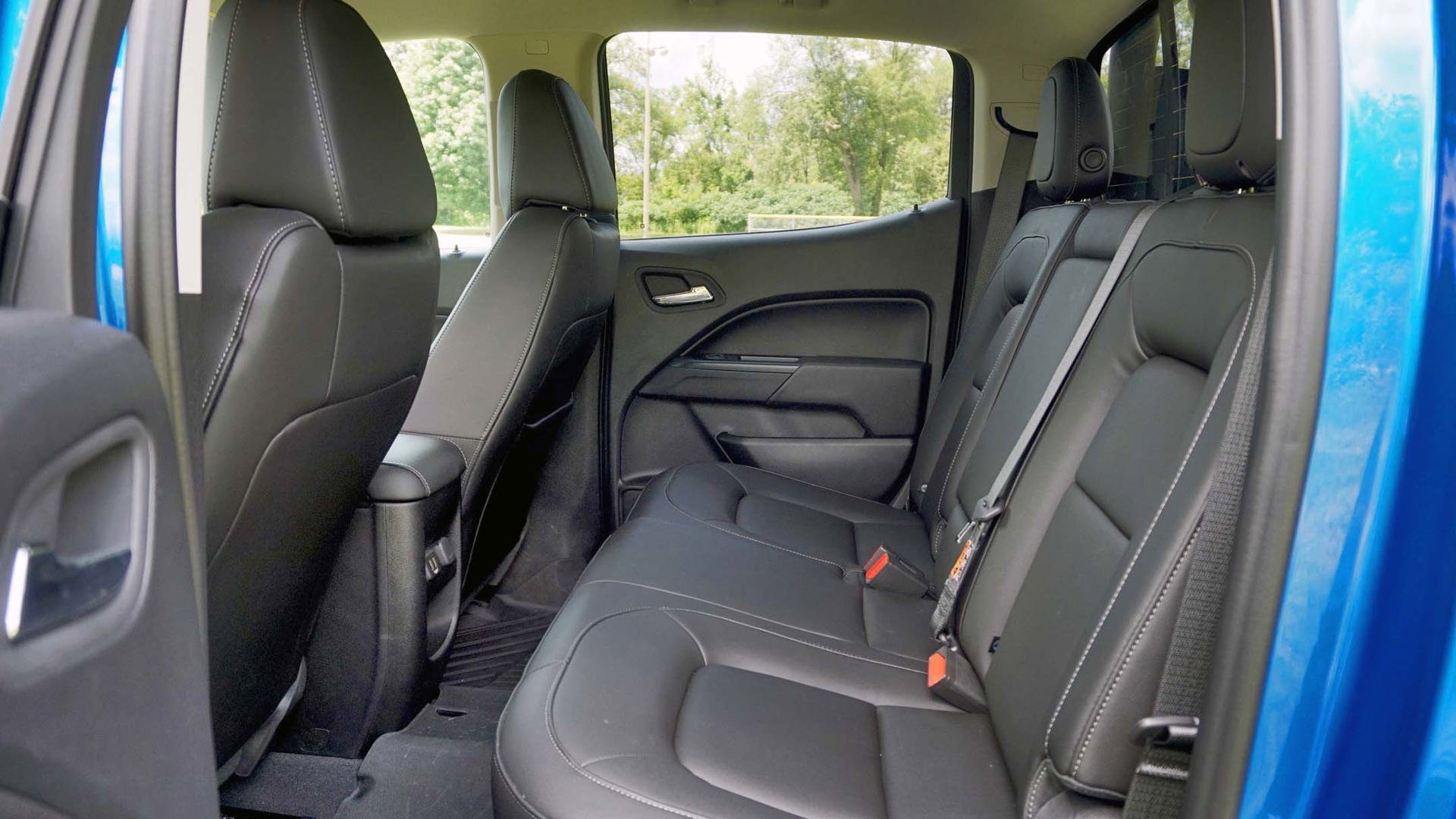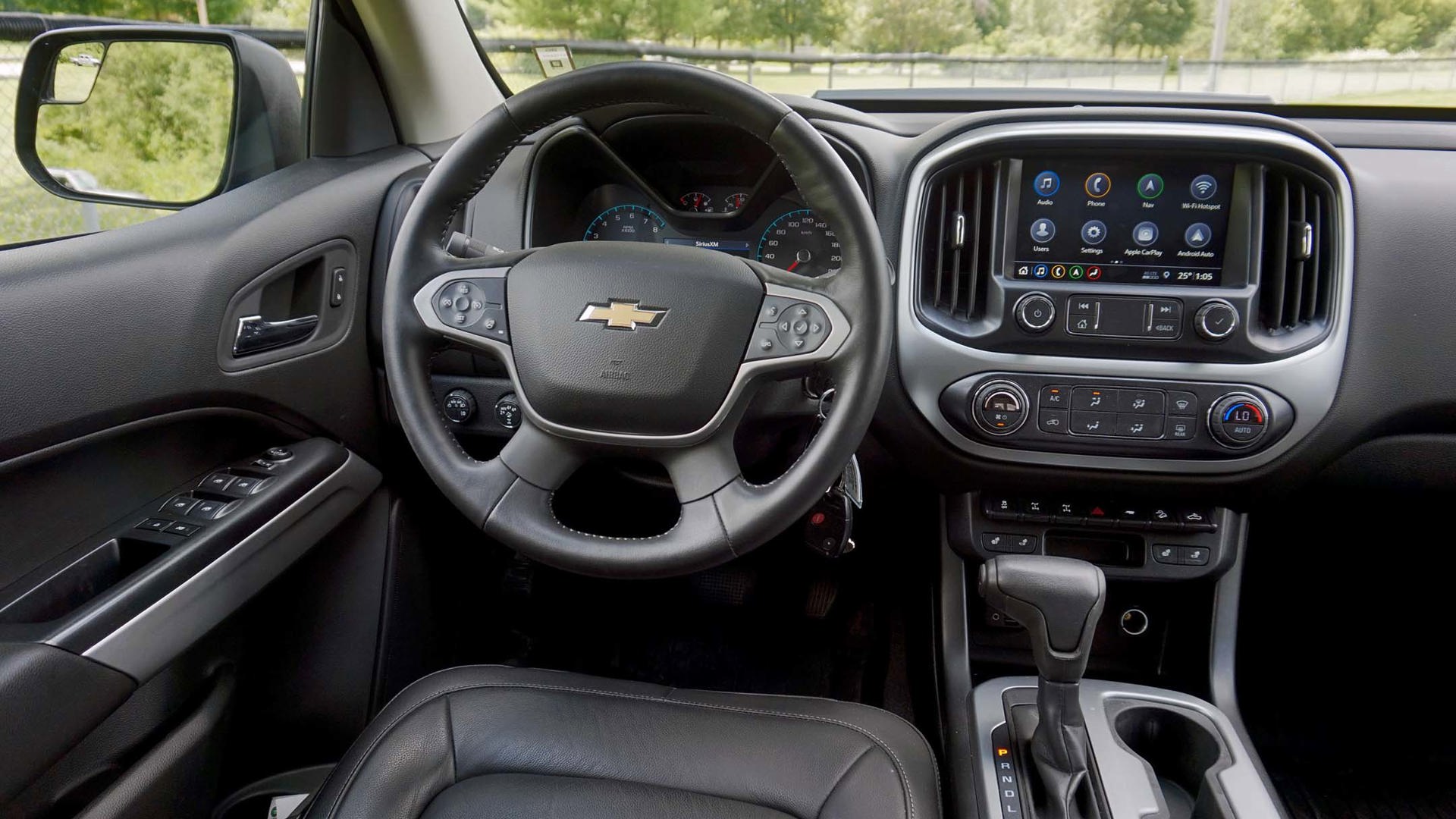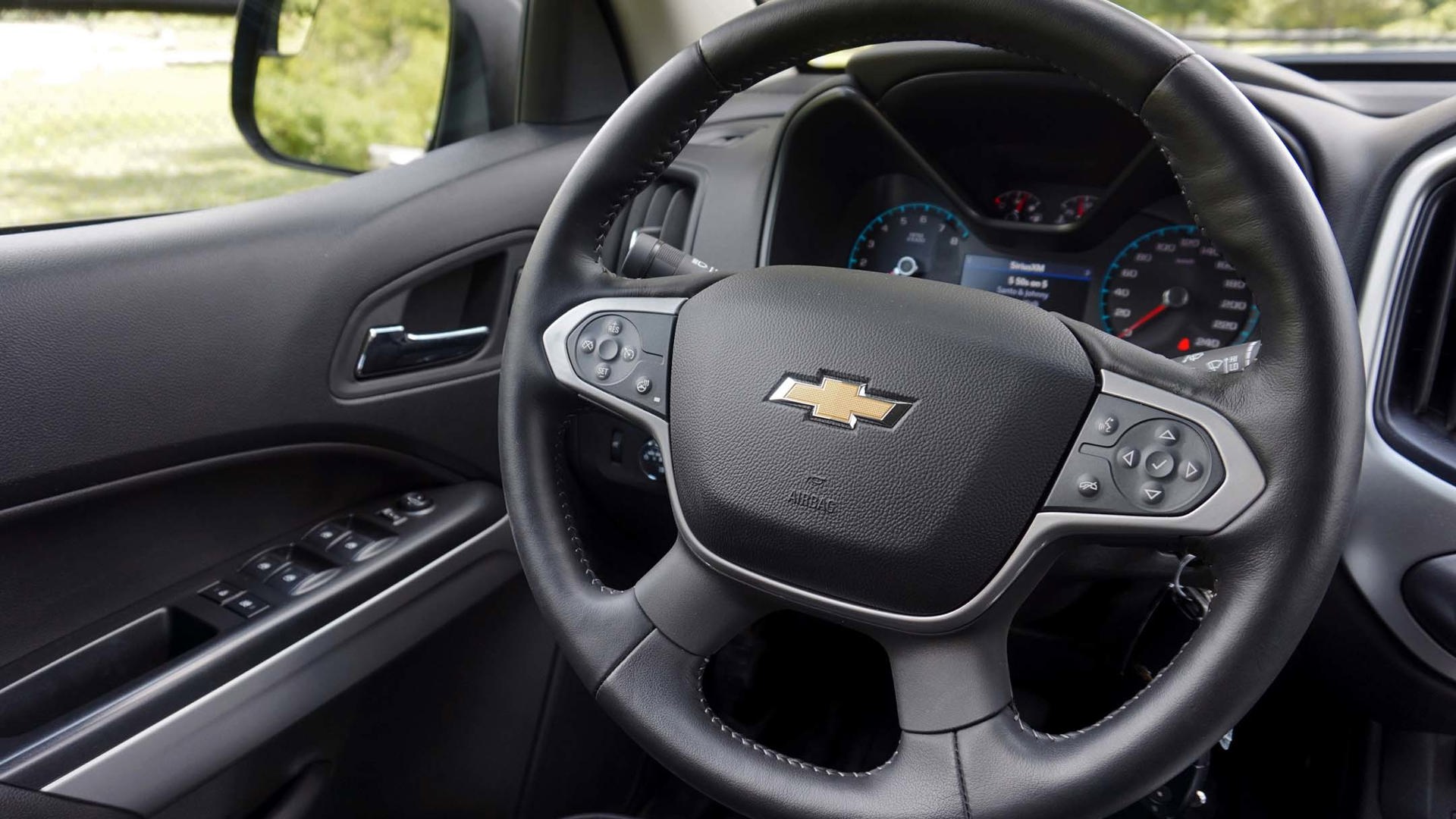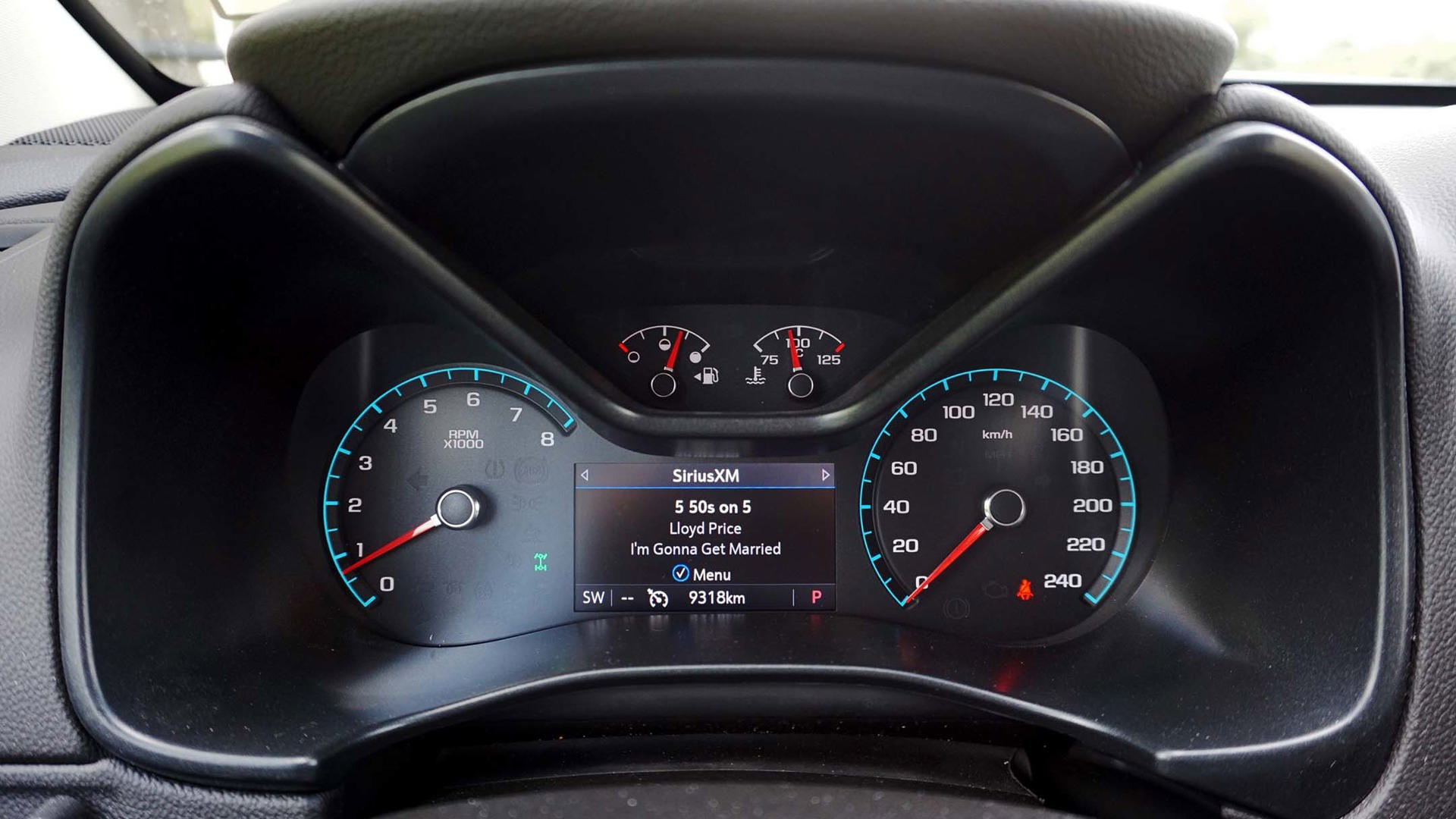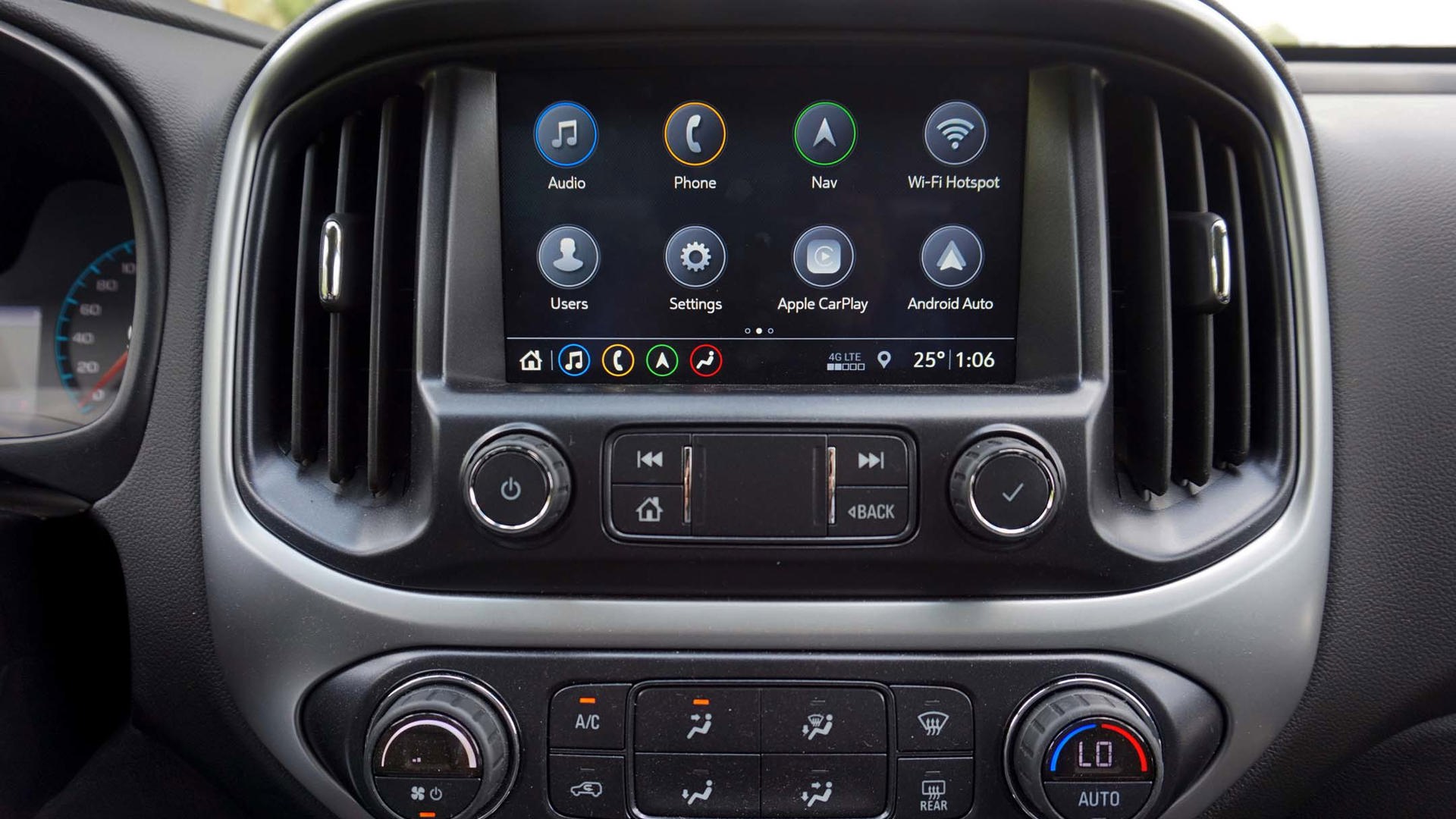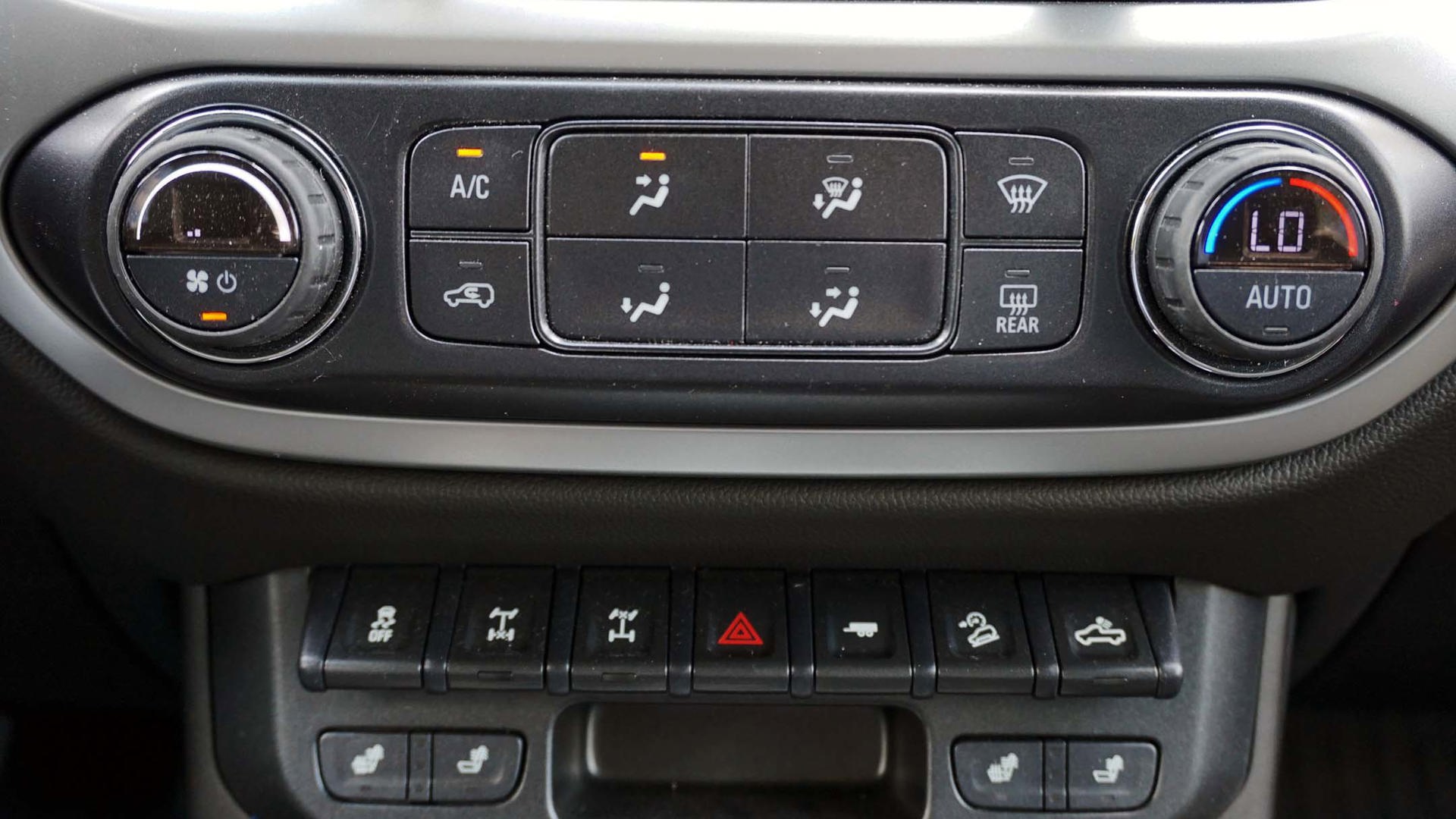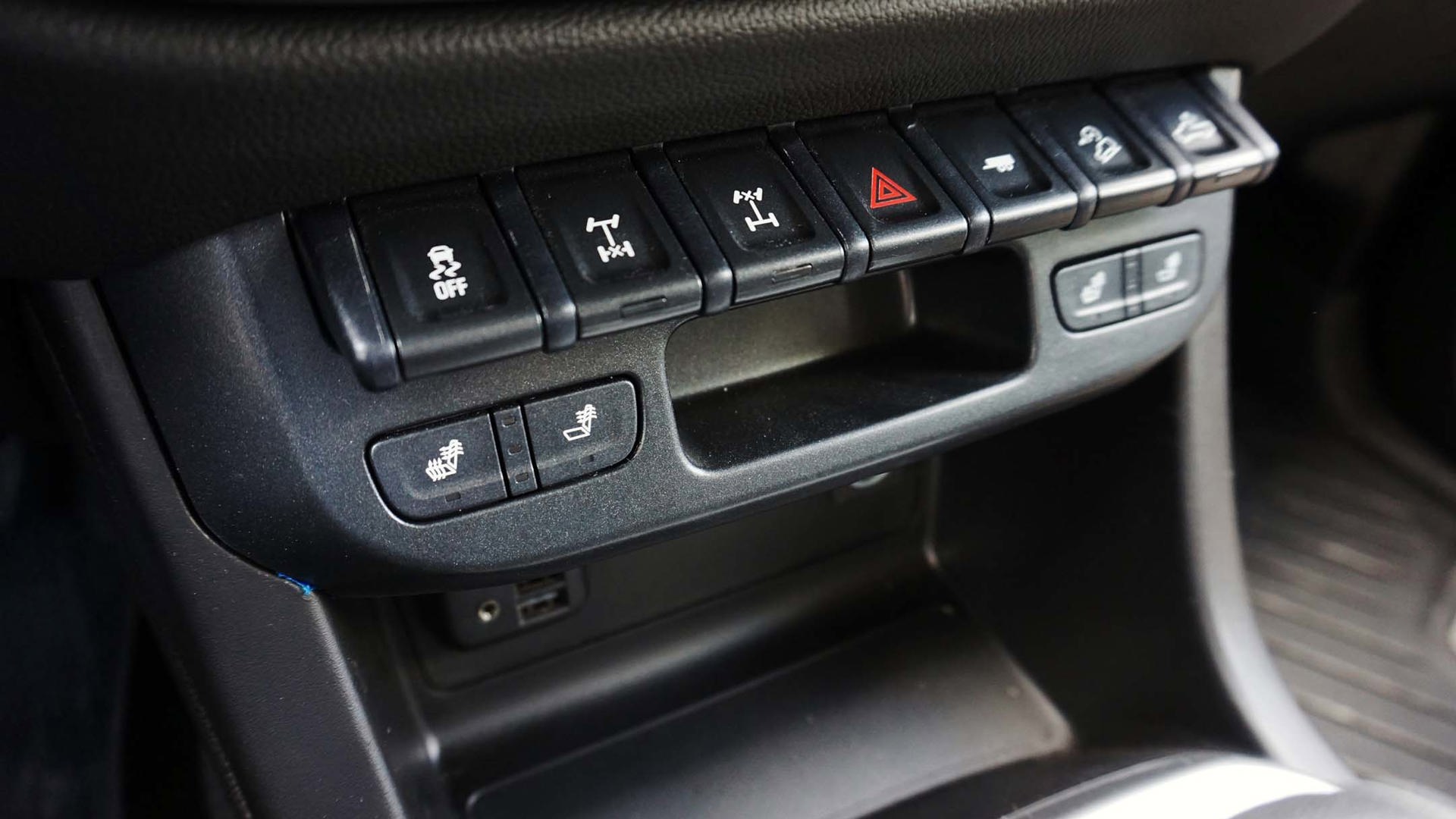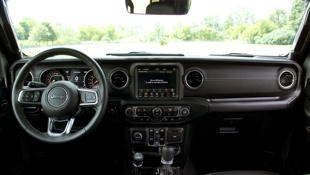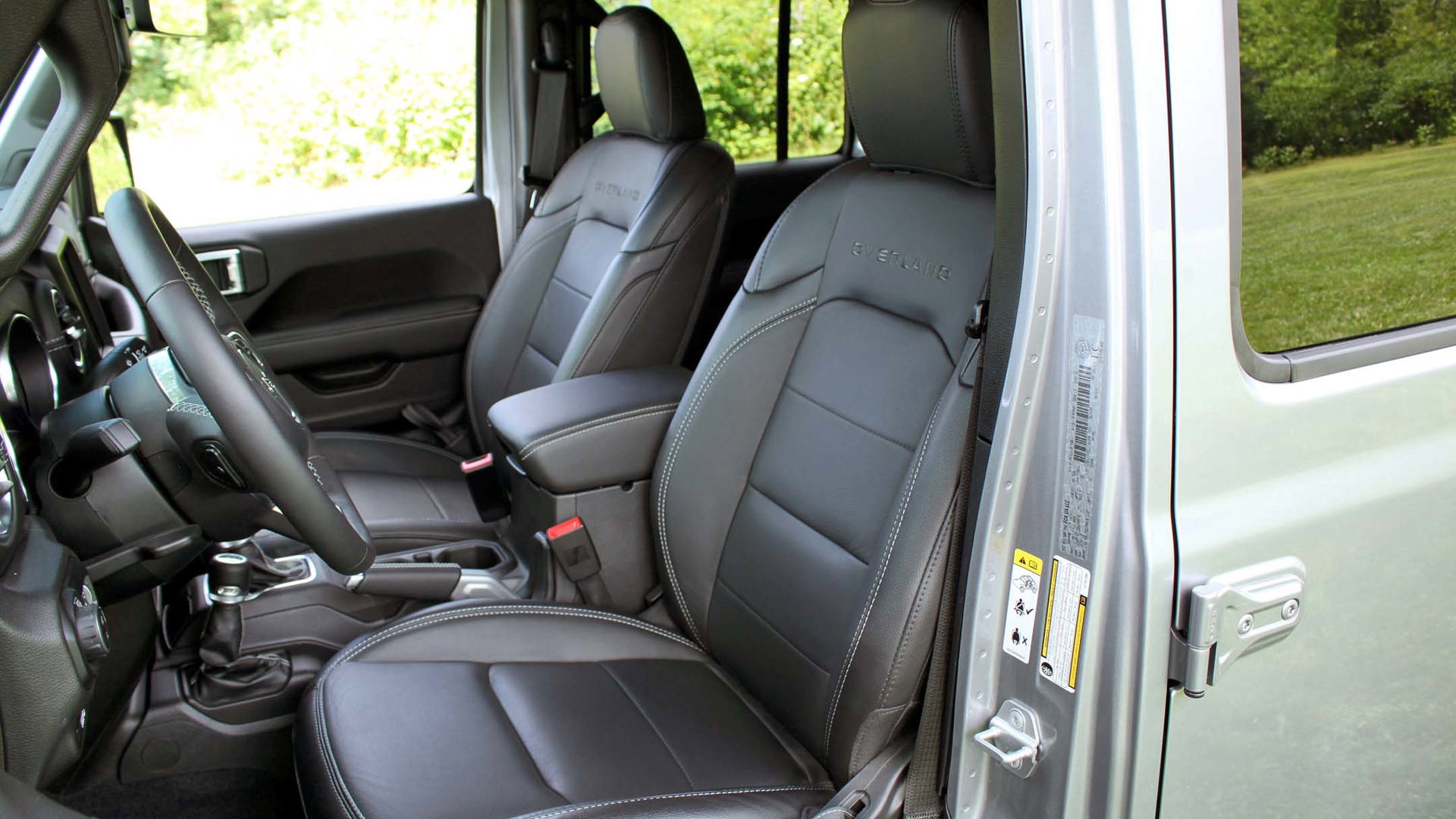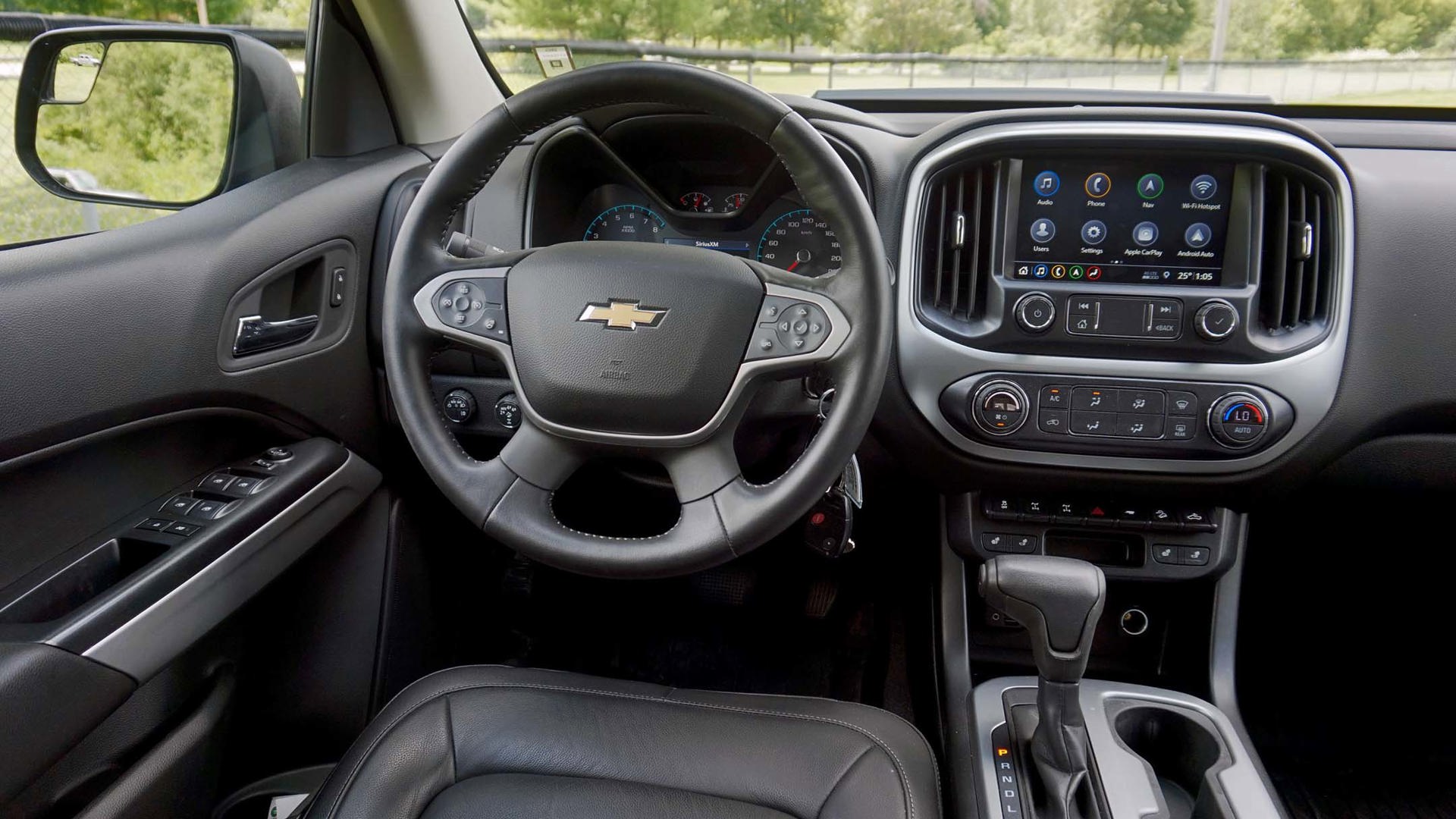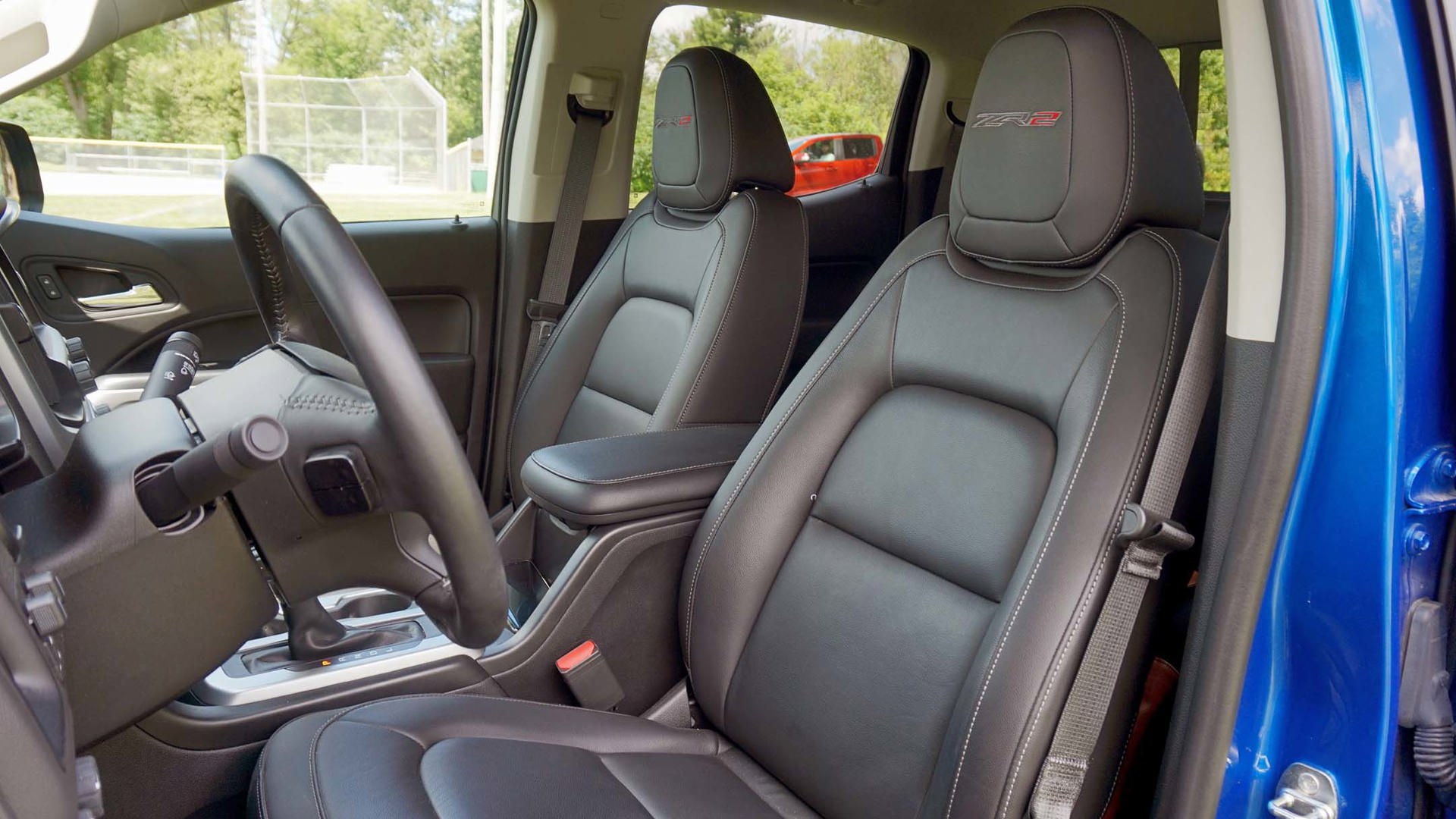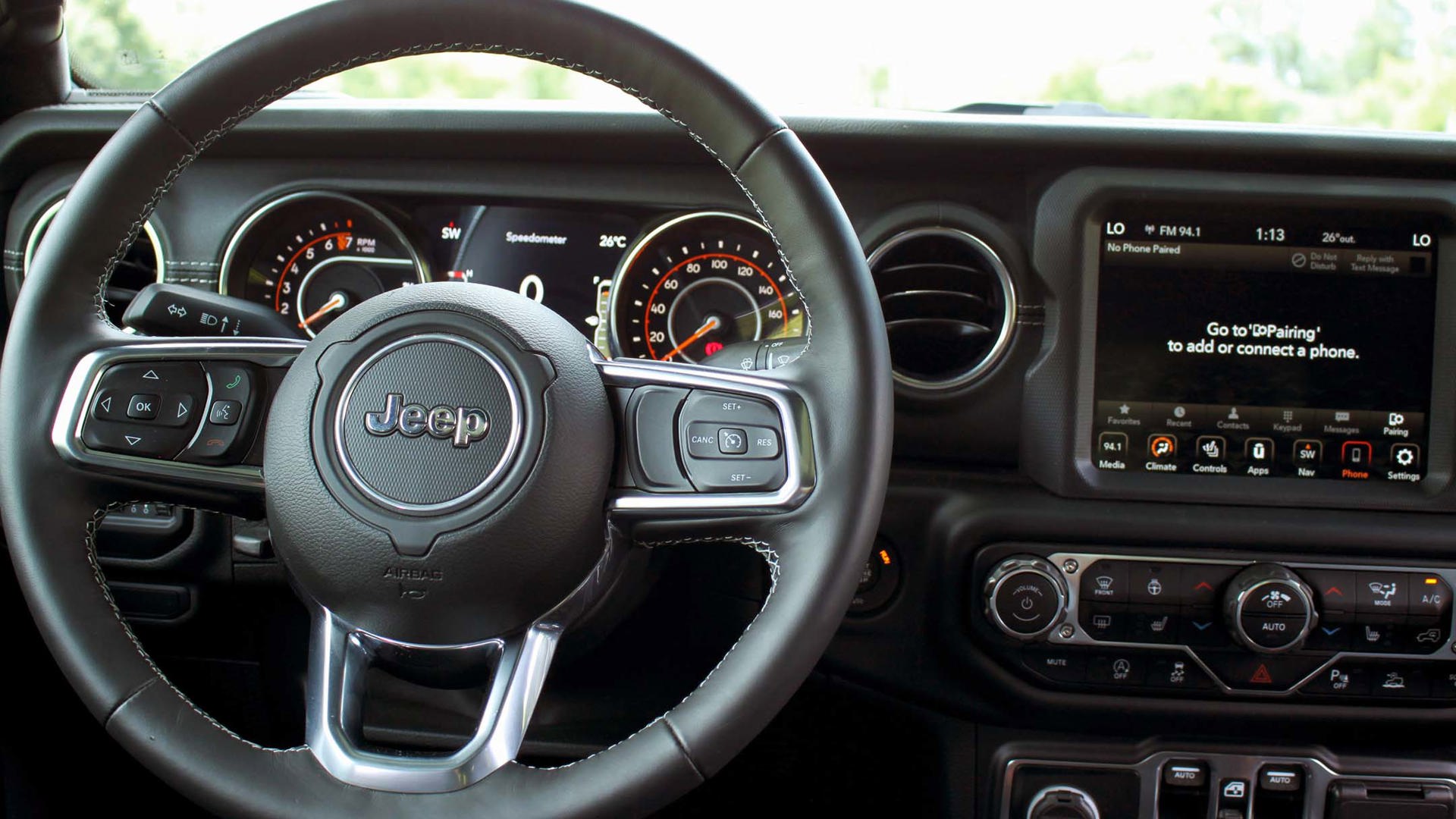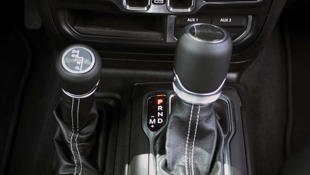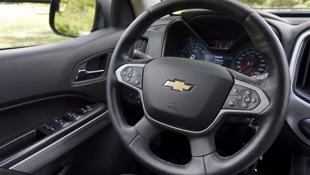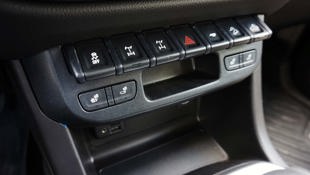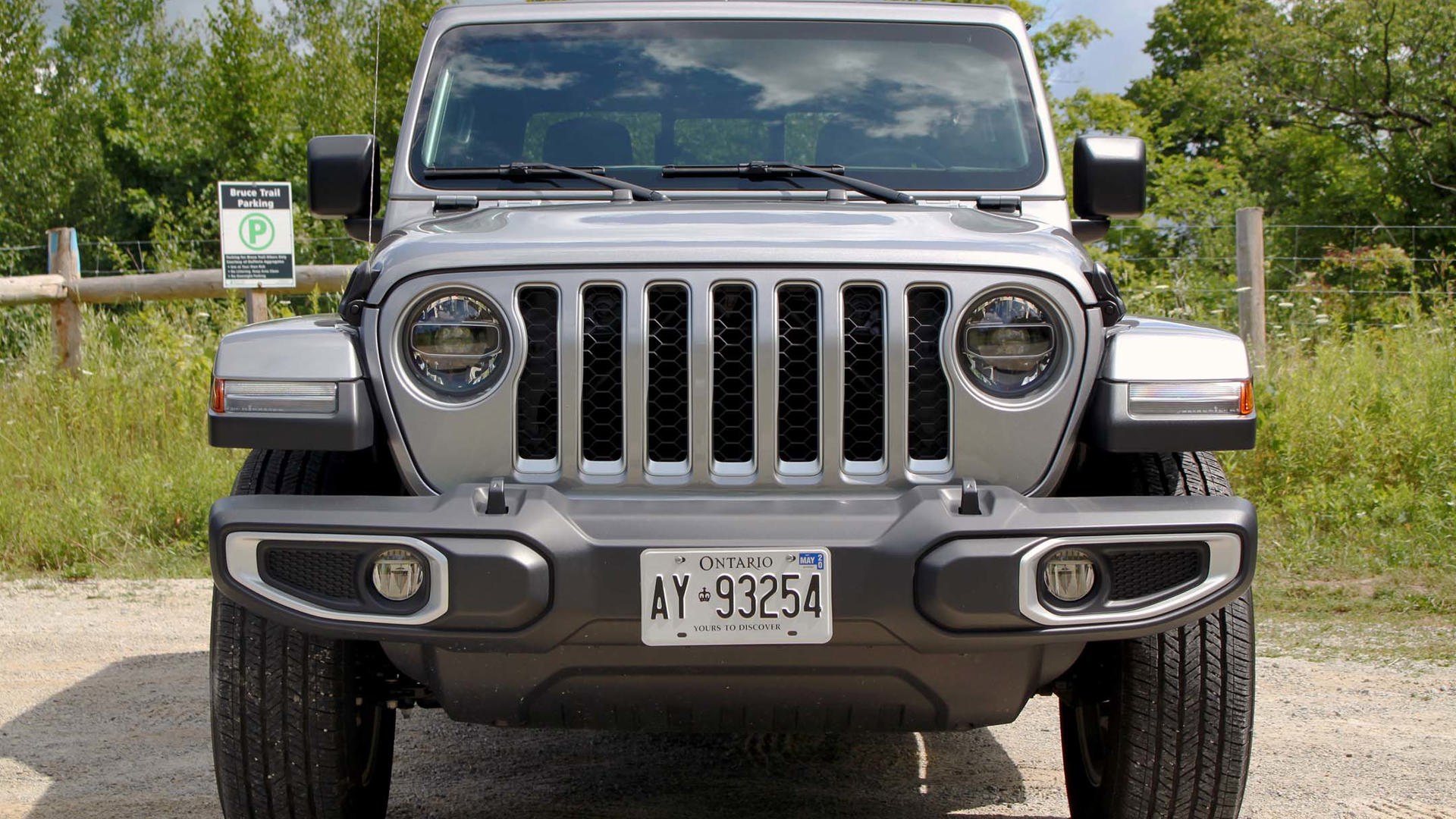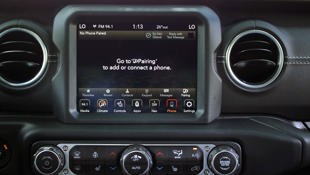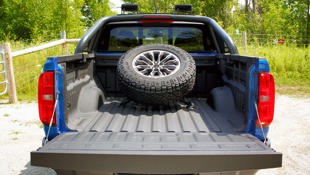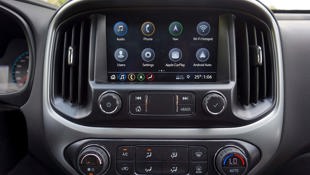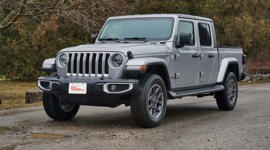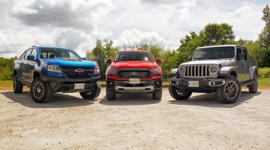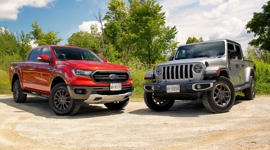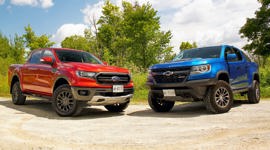Comparison Data
|
2019 Chevrolet Colorado ZR2
|
2020 Jeep Gladiator Overland
|
|---|---|
|
Engine Displacement
3.6L
|
3.6L
|
|
Engine Cylinders
V6
|
V6
|
|
Peak Horsepower
306 hp @ 6, 800 rpm
|
285 hp @ 6,400 rpm
|
|
Peak Torque
275 lb-ft @ 4,000 rpm
|
260 lb-ft @ 4,400 rpm
|
|
Fuel Economy
15.0/13.0/14.1 L/100 km cty/hwy/cmb
|
13.7/10.7/12.3 L/100 km cty/hwy/cmb
|
|
Cargo Space
1,169 L
|
994 L
|
|
Base Price
$47,600
|
$49,495
|
|
A/C Tax
$100
|
$100
|
|
Destination Fee
$1,895
|
$1,895
|
|
Price as Tested
$56,465
|
$63,235
|
|
Optional Equipment
$6,870
|
$11,745
|
A few automakers hang their hat on their off-road abilities, and top among them is Jeep. As more and more trucks with off-road trims came out over the past few years, it became a no-brainer for Jeep to join the pickup truck market themselves. The Gladiator is a mid-size truck that takes the Jeep Wrangler’s iconic design and off-road capability and combines it with the practicality of a truck bed. It’s sure to be a hit with Jeep fans, but it also has to convince truck buyers that it’s actually a real truck.
The Chevrolet Colorado, on the other hand, doesn’t have much convincing to do. It’s one of the most popular mid-size trucks on the market, and it recently upped the ante with a specialized model called the ZR2. This model is designed for the off-road enthusiast, with a lift, skid plates, rock sliders, locking differentials, off-road tires and an exclusive suspension.
Since the Jeep Gladiator is a bit late to the mid-size truck market, the ZR2 has been keeping the off-road crowd happy. But now that the Jeep is here and off-road-ready right from the get-go, will Chevy vacate the throne?
Exterior
Both of these trucks exude a tough attitude and earn attention at every stoplight. It’s surprising to me that people take notice of the Gladiator – the front three-quarters of it looks pretty much identical to a Jeep Wrangler – yet it received hat tips, thumbs-ups, waves, and more: People seemed to really dig the big Jeep. Despite all the attention the Jeep gained from spectators, to me the proportions are really awkward: The bed looks a bit too small, and in Overland guise, as with this tester, the truck doesn’t look as beefy or rugged as the top-trim Rubicon models. It actually looked a little wimpy compared to the Colorado ZR2. Fortunately, it has a somewhat functional side-step that helps with entry into the cabin.
The ZR2 was equally impressive in terms of getting attention, as it’s hard to ignore the bright blue paint, black accents, raised ride height, and huge tires – especially the spare taking up half the bed. It looks like a road-ready trophy truck. Unlike the Gladiator, it seems like there is no bad angle to spot on the Colorado. The skid plate and rock sliders show that the ZR2 is ready for serious business in a way the Jeep doesn’t. Our model also had a light bar behind fitted above the cab, which looked cool, but made entering parking garages a bit sketchy. Sure, a few of the accessories are not very practical, but it all makes sense in the context of an off-road truck.
Chevrolet Colorado Exterior: 9
Jeep Gladiator Exterior: 7.5
Interior
The Jeep Gladiator has a very unique cabin, one that you’d only be familiar with if you have been in a Jeep Wrangler before. There are big knobs, handy toggle switches, and plenty of easy-to-use buttons. Usability and ergonomics are high points in the Gladiator. There is also more space in the cabin, as the Gladiator never feels like a purpose-built truck, instead, it feels like a family-friendly vehicle (that is, if kids can even get into it) with the added benefit of having a truck bed as well. The rear seat bottoms are a bit shallow, but they fold up so you can have extra storage space. There are cubbies under the seats, as well as a place to hold all the screws and bolts when you take the doors and roof off. It’s also worth pointing out that the Jeep has an easy-to-use infotainment system, but we’ll dive into the tech later.
The Colorado is familiar too but in a less attractive way. It features a design that’s well worn by now and looks identical to any other Chevrolet product, be it a truck, SUV, or crossover. The plastics and buttons look low-rent, and they quickly attract scratches, lint, and dirt. The Chevy has a bit more legroom in the front, but that’s about it in terms of advantages over the Jeep. The visibility isn’t great – the vista in the rear-view mirror is blocked by that knobby tire mounted in the bed, and that big bump in the hood doesn’t help the view ahead. The seats are also nothing to get excited about. We found the Chevy MyLink infotainment system to be a solid piece of technology, although it does take a while to boot up.
Chevrolet Colorado Interior: 6
Jeep Gladiator Interior: 7
Utility
Neat styling and spacious interiors are good and all, but trucks are meant for work, and if they can’t do the basics of trucking, then what’s the point? The Gladiator gets the memo loud and clear. As equipped, it’s pretty capable. Our tester is rated to tow 6,000 lb, and has a payload rating of 1,120 lb. It’s important to note that these aren’t the max ratings available for the Gladiator, just our Overland model. Other trim levels of the Jeep will be a touch more capable with a tow rating of 7,650 lb and a payload rating of 1,600 lb. More important than towing or hauling is how much space is in the bed. This is where the Gladiator loses its footing a bit, as it features just 994 litres of bed volume. It’s still practical, as I filled the bed with painful memories and garbage (okay, it was all garbage) from my garage to take to the dump. One trip is all it took, but that might be saying more about my life than the Jeep.
The Colorado ZR2 isn’t meant to tow or haul, but it will manage if called upon. This tester is able to tow a maximum of 5,000 lb and a payload of 1,100 lb. If that’s your reason for buying a truck, we’d advise you to steer clear of the ZR2 model, since other Colorado models can tow up to 7,700 lb or haul 1,566 lb. Still, the ZR2 is a truck and it should be expected to carry out these duties, but in order to do anything with the bed, you’ll need to remove the spare tire mount, which seems daunting, but should be easy for those who are handy with a set of tools. Once you do so, you’re rewarded with a truck bed that offers 1,169 litres of volume, a good chunk more than the Jeep.
If a customer is looking to tow or haul, we would recommend looking at a half-ton truck instead. Buyers in this class will want the usefulness of the bed and will prioritize that over towing capability. The Colorado is more practical, but only when you get rid of that spare tire mount.
Chevrolet Colorado Utility: 7
Jeep Gladiator Utility: 7
Powertrain
The 3.6-litre V6 engine in the Jeep makes 285 hp and 260 lb-ft of torque. It’s paired to an eight-speed transmission. Gear-changes land without shift-shock, making for a smooth ride, but the Gladiator is in a hurry into the highest gear possible. The Jeep seems to have a priority on fuel economy, and that can get in the way of enjoying the Gladiator. As a result, it sometimes feels sluggish while making a pass or getting up to highway speeds, although it does feel solid off the line. Some must-haves if you intend on going seriously off-road are the four-high and four-low settings.
The Colorado also uses a 3.6-litre V6 engine, but it has a bit more oomph than the Jeep. It makes 308 hp and 275 lb-ft of torque. It’s a shame that Chevy didn’t give the motor anything extra in this ZR2 model, but that’s just fine as its output proves to be more than enough in this application. This motor is also mated to an eight-speed automatic, which feels a bit more proactive when changing gears and getting the truck up to speed, be it off the line or already in motion.
Chevrolet Colorado Powertrain: 8.5
Jeep Gladiator Powertrain: 7.5
Driving
There are times when you’re driving the Gladiator where it feels almost identical to the Jeep Wrangler. But more often than not, it feels like a Wrangler in the worst way. The steering in particular is floaty and vague with zero feedback. There’s a large dead-zone in the centre of the wheel, meaning nothing really happens for a wide range of steering input. It lumbers from lane to lane and feels awkward in corners. While the ride is comfy, you can hear the wheels thumping on the pavement at times, delivering an unrefined experience to say the least. Jeep fans know that these same driving manners allow the Gladiator to excel off-road, so it makes some sense that the truck handles this way.
Off-road, the Gladiator drives more reliably and naturally. It swallows up bumps pretty easily and is confident on loose surfaces, even in the non-Rubicon trim level. Hill descent control is available too, which helps in some situations. The Gladiator Overland features a generous 25.4 cm of ground clearance, and combines that with an approach angle of 40.8 degrees, breakover angle of 18.4 degrees, and departure angle of 25 degrees. It has excellent approach and departure angles, but that breakover angle isn’t ideal as a result of the long wheelbase.
As capable as the Gladiator is, the Colorado ZR2 is far more refined and well-rounded. It sets the benchmark for ride quality, both on-road and off. It’s seriously impressive just how responsive and well-mannered the ZR2 is on road. This is how all trucks should ride: nice and soft on the pavement with a touch of road feel. It’s thanks to the ZR2’s special dampers, known as Dynamic Suspension Spool Valve (or DSSV) dampers. They’re built by Multimatic, who are based in Markham, Ontario. Versions of these DSSV dampers are used in a number of high-end vehicles, including the Mercedes-AMG GT, Aston Martin Vulcan, Ford GT and the Camaro ZL1 1LE. The Colorado ZR2 is vastly different than those cars, yet still blends performance and comfort; except in this case, it’s about meshing on-road and off-road conditions.
Confident perfectly describes the ZR2 in either on- or off-road scenarios. It gives you the perfect amount of leeway in terms of steering and ride. The ZR2 also features locking differentials for the front and rear to go along with the same drive-wheel selection found in the Jeep Gladiator. It feels just as capable than the Gladiator, even though it features less ground clearance with just 22.6 cm and limited approach and departure angles of 30 degrees and 23.5 degrees. The ZR2 does have a better breakover angle than the Gladiator at 23.5 degrees.
Chevrolet Colorado Driving: 9
Jeep Gladiator Driving: 7
Fuel Efficiency
Although these are trucks, fuel efficiency should still be a high priority for buyers, especially since drivers wouldn’t want to be stranded without fuel while out on an adventure. The Jeep manages the more palatable fuel usage of the two, with NRCan estimates of 13.7 L/100 km in the city and 10.7 L/100 km on the highway. On a quick rural test route, we managed 11.5 L/100 km, which isn’t bad at all.
The Colorado ZR2 is rated at 15.0 L/100 km in the city and 13 L/100 km on the highway, resulting in a 14.1 L/100 km combined rating. After our test drive, the ZR2 returned 12.6 L/100 km, besting its combined figures but using more fuel than the Gladiator.
Jeep Gladiator Fuel Efficiency: 8
Chevrolet Colorado Fuel Efficiency: 7
Safety/Technology
Despite its old school look, the Jeep feels like a slightly more modern vehicle in the cabin. The 8.4-inch UConnect touchscreen infotainment system is easy to use and responsive, with features like Android Auto and Apple CarPlay support. There are two USB ports in the front and a USB-C type connector too. Furthering its appeal as a family-friendly vehicle, there are more USB ports in the rear as well as a three-pronged 115-volt AC plug. The Gladiator also features a blind spot monitoring system. The rear-view camera and parking sensors are also pretty good, and we never felt like a truck-newbie while reversing into spots.
The Chevrolet Colorado shouldn’t be discounted in this conversation, as it is well equipped from a tech standpoint. At 8-inches, the screen on the Chevrolet MyLink infotainment system is a bit smaller than the Jeep’s, but they have many of the same features, including Android Auto and Apple CarPlay compatibility. There is a handy wireless phone charger in the ZR2, which is very appreciated, but it doesn’t fit larger phones. Both cars feature remote start technology to keep the car cool or warmed up depending on the season. Unfortunately, the Colorado lacks the same safety equipment the Gladiator offers, a shame since the Gladiator doesn’t have very many at all. The Colorado is so low tech, it uses a real crank key instead of a push-button start, leaving us to wonder, “What year is it?”
Chevrolet Colorado Safety/Technology: 6.5
Jeep Gladiator Safety/Technology: 7.5
Value
Usually, smaller vehicles are more affordable, but this isn’t the case, as both of these mid-sized trucks are quite expensive. Our Jeep Gladiator Overland, as equipped, was priced at $63,235 which is a significant amount of money. Sure, it’s well equipped, spacious and fuel efficient, but you get a very unrefined driving experience. It’s easy to say the Gladiator has a few more pros than cons, but there’s something about Colorado we just can’t shake.
To begin with, the Colorado ZR2 as equipped comes to $56,465, making it more affordable than the Jeep. It also has a more potent powertrain, which is necessary when it comes to off-roading and dune-bashing. It looks good too, and it rides like no other truck. Sure it isn’t the lushest place to sit, and it’s lacking some fancy features, but the Colorado ZR2 nails the things that matter in an off-road-ready truck, including features like locking differentials, which are only available on the Rubicon version of the Gladiator and will bump up the price even higher. You get more truck for less money in the Colorado ZR2, but more of everything else in the Gladiator.
When it comes to this class, we’ll go with the more enjoyable truck, as these are essentially big toys. The ZR2 takes this category.
Jeep Gladiator Value: 6.5
Chevrolet Colorado Value: 8
The Verdict
We expected the Chevrolet Colorado to show its age, and for the Jeep Gladiator to show its expertise, so it goes without saying that we were surprised at the results of our test. The Colorado in ZR2 trim looked as fresh and cool as ever, and also managed to be very refined on-road and off. The Jeep, on the other hand, was spacious, fuel-efficient, and well equipped, but felt let down by horrible driving dynamics and a high price tag.
The Gladiator is hard to recommend here since a Wrangler will feel more confident on- and off-road, and there are more-capable pickup trucks around for less money. It just felt compromised. The ZR2, on the other hand, is a focussed vehicle that nails the basics and then a bit more too. We jumped out of it with a smile, and that’s exactly the kind of impact an off-road truck like this should have.
Chevrolet Colorado: 61/80
Jeep Gladiator: 58/80
